Most cited
- Page Path
- HOME > Browse Articles > Most cited
Most-cited are based on citations from 2024 ~ 2026.
Research Articles
- [Korean]
- Intake of energy and macronutrients according to household income among elementary, middle, and high school students before and during the COVID-19 pandemic: a cross-sectional study
- Chae-Eun Jeong, Heejin Lee, Jung Eun Lee
- Korean J Community Nutr 2024;29(3):234-252. Published online June 30, 2024
- DOI: https://doi.org/10.5720/kjcn.2024.29.3.234
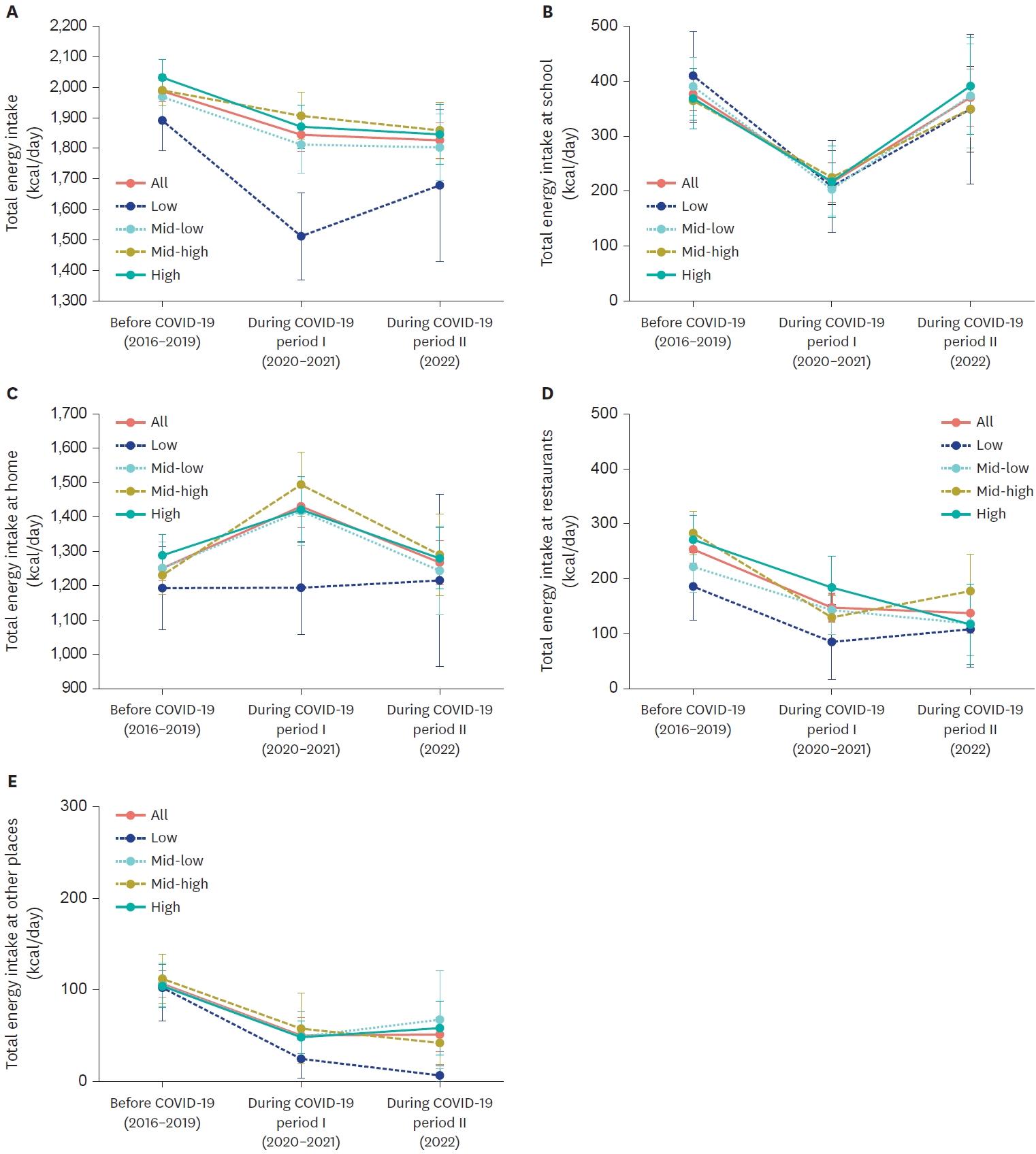
-
 Abstract
Abstract
 PDF
PDF - Objectives
This study examined the intake of energy and macronutrients among elementary, middle, and high school students according to household income before the COVID-19 pandemic (2016–2019), during the social distancing period (2020–2021), and after the social distancing measures were lifted (2022).
Methods
We included 5,217 students aged 5–18 from the Korea National Health and Nutrition Examination Survey (KNHANES) conducted between 2016 and 2022. Dietary intake was assessed using one-day 24-hour dietary recalls. We estimated the least squares means (LS-means) of intake according to household income for each period using a weighted linear regression model, adjusted for age and sex. Differences in LS-means between the periods were analyzed using the t-test.
Results
During the social distancing period, the LS-means of energy intake among students decreased significantly by 143.2 kcal/day compared to pre-pandemic levels (P < 0.001). Students from low-income households experienced a more pronounced decrease in energy intake (−379.1 kcal/day, P < 0.001) and macronutrient intake compared to those from other income groups. Energy intake at school significantly declined for all income groups during the social distancing period compared to before the pandemic. No significant changes in home energy intake were observed among low-income students, whereas there was an increase for students from higher-income groups. Before the pandemic, 8.5% of students from low-income households reported insufficient food due to economic difficulties; this figure rose to 21.3% during the pandemic.
Conclusions
During the pandemic, students from low-income families experienced significantly lower intake of energy and macronutrients compared to pre-pandemic levels. The most substantial reductions were noted among low-income students, largely due to the lack of compensation for decreased school-based intake with increased intake at home. -
Citations
Citations to this article as recorded by- Dietary Assessment and Trends Among Preschoolers in South Korea: Data from KNHANES 2012–2021
Yong-Seok Kwon, Ye-Jun Kim, Eun-Kyung Kim, Jin-Young Lee, Yangsuk Kim, Sohye Kim
Nutrients.2026; 18(2): 240. CrossRef - How Did the Dietary Behavior of Older Korean Adults Change During the COVID-19 Pandemic?
Yong-Seok Kwon, Dasol Kim, Hee-Sook Lim
Nutrients.2025; 17(12): 1973. CrossRef - Dietary Assessment of Older Korean Adults by Level of Plant Protein Intake
Yong-Seok Kwon, Ye-Jun Kim, Jeong-Hun Song, Yangsuk Kim
Nutrients.2025; 17(12): 1976. CrossRef - Analysis of Risk Factor Changes for Myopia in Korean Adolescents Before and After the COVID-19 Pandemic
Seeun Lee, So Ra Kim, Mijung Park
Medicina.2025; 61(10): 1798. CrossRef - Changes in Ultra-Processed Food Consumption among Adolescents before and after the COVID-19 Pandemic : Using Data from the 7th (2018~2019) and 8th (2020~2021) Korea National Health and Nutrition Examination Survey
Hyun-Jin Hwang, Yoo Kyeong Kim
Korean Journal of Human Ecology.2024; 33(6): 981. CrossRef
- Dietary Assessment and Trends Among Preschoolers in South Korea: Data from KNHANES 2012–2021
- 2,884 View
- 106 Download
- 5 Crossref

- [Korean]
- Comparative study on the health and dietary habits of Korean male and female adults before and after the coronavirus disease 2019 pandemic: utilizing data from the 8th Korea National Health and Nutrition Examination Survey (2019–2021)
- Chaemin Kim, Eunjung Kim
- Korean J Community Nutr 2024;29(1):65-80. Published online February 29, 2024
- DOI: https://doi.org/10.5720/kjcn.2024.29.1.65
-
 Abstract
Abstract
 PDF
PDF - Objectives
This study aims to compare changes in physical factors, health behaviors, eating habits, and nutritional intake among Korean male and female adults over a period of three years (2019–2021) before and after the outbreak of coronavirus disease 2019 (COVID-19).
Methods
This study utilized raw data from the 8th Korea National Health and Nutrition Examination Survey (2019–2021). The participants in this study included 6,235 individuals in 2019, 5,865 individuals in 2020, and 5,635 individuals in 2021. Individuals whose daily energy intake was less than 500 kcal or exceeded 5,000 kcal were excluded from the study.
Results
In comparison to 2019, overweight/obesity rates, weight, waist circumference, weekend sleep hours, and resistance exercise days/week increased in both male and female during the COVID-19 pandemic. Regarding eating habits, the proportions of people skipping breakfast, not eating out, consuming health supplements, and recognizing nutritional labels increased in 2020 and 2021, whereas the rate of skipping dinner decreased. Total energy intake has continued to decrease for the two years since 2019. A comparison of nutrient intake per 1,000 kcal before and after the outbreak of COVID-19 revealed that intake of nutrients, including protein, phosphorus, iron, vitamin A, riboflavin, and niacin increased, while folic acid intake decreased. In male, calcium, phosphorus, riboflavin, and niacin intakes increased, whereas iron, vitamin C, and folic acid intakes decreased. In female, phosphorus, iron, vitamin A, and riboflavin intake increased significantly, while protein and niacin intake decreased significantly.
Conclusions
After COVID-19, the obesity rate, breakfast skipping rate, health supplement intake, and nutritional label use increased, while the frequency of eating out, dinner skipping rate, and total energy intake decreased. These environmental changes and social factors highlight the need for nutritional education and management to ensure proper nutritional intake and reduce obesity rates in the post-COVID-19 era. -
Citations
Citations to this article as recorded by- Status of Use of Protein Supplement Products according to the Health Concerns of Adults in Their 20s and 30s
Cho-In Oh, Bok-Mi Jung
Journal of the East Asian Society of Dietary Life.2025; 35(1): 9. CrossRef - A study on regional differences in dietary behaviors and satisfaction in Korea focusing on urban and rural comparisons: a cross-sectional study
Jong-Youn Rha, Sohyun Kim, Hae-Rang Lee, Juhyeon Kil
Korean Journal of Community Nutrition.2025; 30(2): 140. CrossRef - How Did the Dietary Behavior of Older Korean Adults Change During the COVID-19 Pandemic?
Yong-Seok Kwon, Dasol Kim, Hee-Sook Lim
Nutrients.2025; 17(12): 1973. CrossRef - Intake of energy and macronutrients according to household income among elementary, middle, and high school students before and during the COVID-19 pandemic: a cross-sectional study
Chae-Eun Jeong, Heejin Lee, Jung Eun Lee
Korean Journal of Community Nutrition.2024; 29(3): 234. CrossRef - 성인 남녀의 먹방 시청시간에 따른 식행동에 대한 연구
하얀 남, 복미 정, 은례 전
Korean Journal of Food and Cookery Science.2024; 40(4): 275. CrossRef
- Status of Use of Protein Supplement Products according to the Health Concerns of Adults in Their 20s and 30s
- 5,609 View
- 85 Download
- 5 Crossref

- [Korean]
- An educational needs analysis of sustainable dietary education for nutrition teachers: an application of the IPA, Borich needs assessment and The locus for focus model
- Eunseo Yang, Borham Yoon
- Korean J Community Nutr 2024;29(5):372-381. Published online October 31, 2024
- DOI: https://doi.org/10.5720/kjcn.2024.00008

-
 Abstract
Abstract
 PDF
PDF - Objectives
This study aimed to investigate the importance and performance levels of sustainable dietary education across the health, environment, and society domains as perceived by nutrition teachers and evaluate the needs and priorities for sustainable dietary education.
Methods
An online survey was conducted for 151 nutrition teachers in Jeollanam-do. The survey included 20 questions across the health, environment, and society domains. The data were analyzed using a paired-sample t-test, the importance-performance analysis (IPA), the Borich needs assessment model, and the locus for focus model.
Results
Overall, the average importance levels of the 20 items of sustainable dietary education were significantly higher than their average performance levels (4.44 vs. 3.68). The examination of each educational domain revealed that although the importance of education in the health domain was recognized and actively practiced by the nutrition teachers, the performance was comparatively lower in the environment and society domains. The Borich needs assessment and the locus for focus model identified education on biodiversity conservation, plant-based protein, and the use of local food as the top-priority group in the environment domain along with fair and ethical food, food security, regional food culture, food policy and trade, and family dining culture as the second-priority group in the society domain.
Conclusions
The results of this study underscore the need to support the nutrition teachers’ perception and practice of sustainable dietary education in the environment and society domains. We believe that the educational needs and priorities proposed in this study will be considered in the future development and modification of sustainable dietary education programs. -
Citations
Citations to this article as recorded by- Analysis of pork consumption attribute factors by consumer lifestyle in Korea: a cross-sectional study
Jounghee Lee, Juhyun Lee, Wookyoung Kim
Korean Journal of Community Nutrition.2025; 30(1): 75. CrossRef - An Exploratory Study on the Necessity and Promoting Strategies for School-Based Dietary Education: Focus Group Interviews with Home Economics Teachers
Seung Jae Lee, Ji Eun Oh, Kyung Won Lee
Human Ecology Research.2025; 63(1): 41. CrossRef - Analysis of students’ need for artificial intelligence content in the 「Digital education」 subject
SungAe Kim, Ji Won You
The Journal of Korean Association of Computer Education.2025; 28(7): 71. CrossRef - Safety education status and needs priorities of Korean military food service personnel using the Borich Needs Assessment and the Locus for Focus model: a cross-sectional study
Jeongeun Park, Eunsil Her
Korean Journal of Community Nutrition.2025; 30(4): 261. CrossRef
- Analysis of pork consumption attribute factors by consumer lifestyle in Korea: a cross-sectional study
- 2,543 View
- 75 Download
- 4 Crossref

- [Korean]
- Analysis of the relationship between sugar intake and cancer prevalence: a cross-sectional study using the 8th Korea National Health and Nutrition Examination Survey
- Hye-Ryun Kim, Soo-Kyung Lee
- Korean J Community Nutr 2025;30(1):89-102. Published online February 28, 2025
- DOI: https://doi.org/10.5720/kjcn.2024.00339
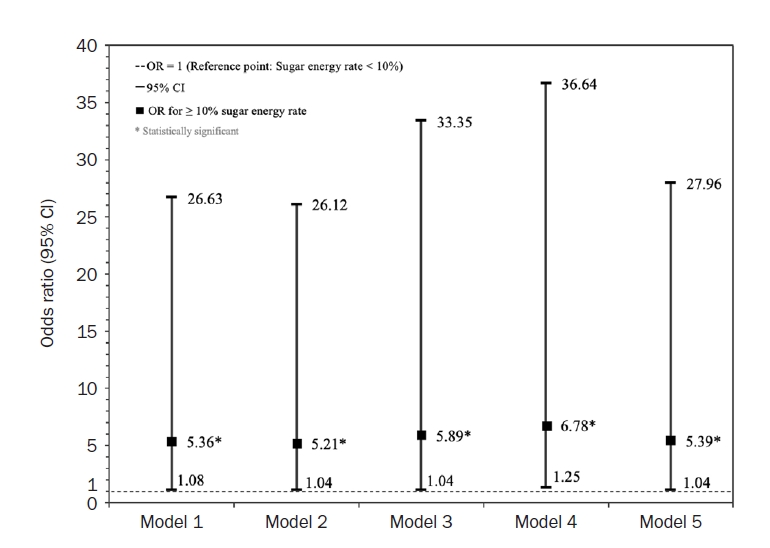
-
 Abstract
Abstract
 PDF
PDF Supplementary Material
Supplementary Material - Objectives
This study aimed to analyze the association between sugar intake and cancer risk among Korean adults aged 19 years and older.
Methods
A total of 13,016 adults aged 19 years and older who participated in the 8th Korea National Health and Nutrition Examination Survey from 2019 to 2021 were included. Sugar intake was assessed in terms of both absolute intake and sugar energy rate. Sugar intake was divided into quartiles, while sugar energy rate was categorized into three groups (< 10%, 10%–20%, > 20%) based on the 2020 Dietary Reference Intakes for Koreans and into two groups (< 10%, ≥ 10%) based on WHO recommendations. Cancer prevalence was determined using cancer-related survey questions. The association between sugar intake and cancer prevalence was analyzed by sex and cancer type using logistic regression. All statistical analyses were performed using IBM SPSS statistics 29.0 (IBM Co.).
Results
From 2019 to 2021, sugar intake significantly declined with age in both men and women (P for trend < 0.001), with the highest intake observed in the 19–29 age group (61.38 g). Men consumed significantly more sugar than women across all age groups except for the 50–64 and 65–74 groups (P < 0.05). However, the sugar energy rate was significantly higher in women than in men (P < 0.05). While the association between sugar intake and cancer prevalence varied across regression models and cancer types, cervical cancer consistently showed a significant association with sugar intake (P < 0.05).
Conclusion
The association between sugar energy rate and the prevalence of premenopausal cervical cancer was consistent and significant. Given that women had a higher sugar energy rate than men, the relationship between sugar intake and cancer prevalence in women warrants further investigation. Longitudinal studies with more detailed sugar intake assessments are needed. -
Citations
Citations to this article as recorded by- A study on hypertension relevant nutritional knowledge and dietary practices in Chinese college students studying in South Korea
Zhe Sun, Wookyoun Cho
Journal of Nutrition and Health.2015; 48(5): 441. CrossRef - Influence of the Size of the Spoon on the Eating rate, Energy Intake and the Satiety Levels of Female College Students
Yang Hee Hong, Young Suk Kim, Hyun Jung Kwon, Do Seok Chang, Dong Geon Kim, Un Jae Chang
Korean Journal of Community Nutrition.2015; 20(5): 375. CrossRef - Dietary behavior and nutritional status among Chinese female college students residing in Korea
Gaowei, Soyeon Kim, Namsoo Chang, Ki Nam Kim
Korean Journal of Nutrition.2013; 46(2): 177. CrossRef
- A study on hypertension relevant nutritional knowledge and dietary practices in Chinese college students studying in South Korea
- 2,724 View
- 94 Download
- 3 Crossref

- [English]
- Regional differences in protein intake and protein sources of Korean older adults and their association with metabolic syndrome using the 2016–2019 Korea National Health and Nutrition Examination Surveys: a cross-sectional study
- You-Sin Lee, Yoonna Lee
- Korean J Community Nutr 2024;29(3):173-188. Published online June 30, 2024
- DOI: https://doi.org/10.5720/kjcn.2024.29.3.173
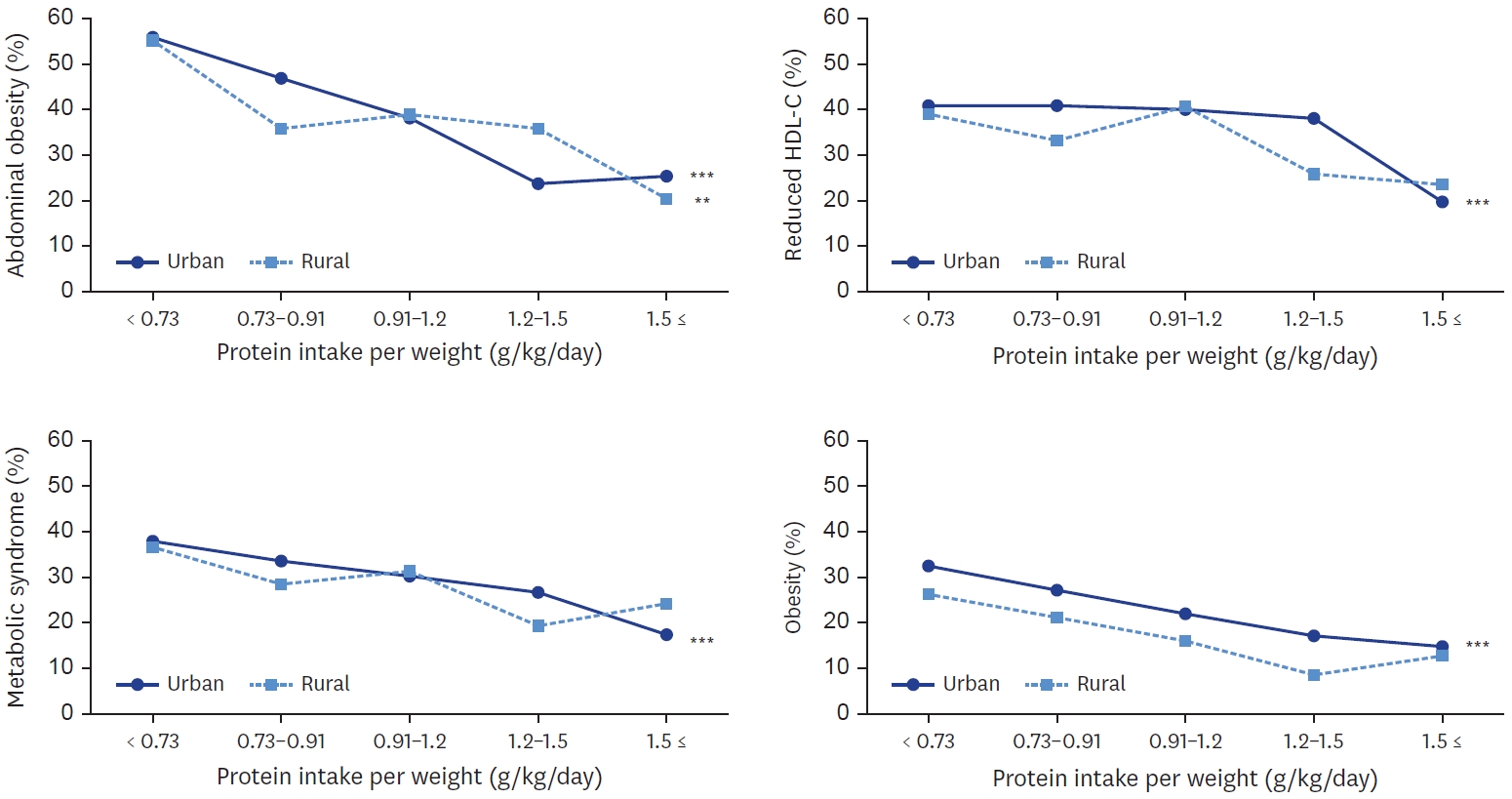
-
 Abstract
Abstract
 PDF
PDF - Objectives
The study aim was to analyze the regional differences in dietary protein intake and protein sources of Korean older adults and their association with metabolic syndrome.
Methods
Study participants were 1,721 older adults aged 65 and over who participated in 2016–2019 Korea National Health and Nutrition Examination Survey. Using 24-hour recall dietary intake data, protein intake and their food sources were examined. The association between protein intake and metabolic syndrome, obesity, and abdominal obesity were analyzed by multiple logistic regression.
Results
Total protein and animal protein intakes were higher in urban area (60.0 g, 24.4 g, respectively) than in rural area (54.6 g, 19.6 g, respectively). With increase of protein intake level, animal to total protein proportion was increased in both areas. Total protein and plant protein intake was negatively associated with the risk of obesity, abdominal obesity in both areas. Animal protein intake was negatively associated with the risk of obesity in both areas, and with abdominal obesity only in urban area. In urban area, plant protein intake was also negatively associated with the risks of metabolic syndrome, elevated triglyceride, and reduced high density lipoprotein-cholesterol. In urban area, the risk of metabolic syndrome was decreased when their protein intake was more than 0.91 g/kg and was lowest when their protein intake was more than 1.5 g/kg (P for trend < 0.001).
Conclusions
Korean older adults showed inadequate protein intake and those in rural area showed lower animal protein intake than in urban area. The risk of obesity and metabolic syndrome was decreased with the increase of protein intake level. These findings may help develop effective nutrition support strategy for older adults to reduce regional health disparity. -
Citations
Citations to this article as recorded by- Assessing Nutritional Factors for Metabolic Dysfunction-Associated Steatotic Liver Disease via Diverse Statistical Tools
Yea-Chan Lee, Hye Sun Lee, Soyoung Jeon, Yae-Ji Lee, Yu-Jin Kwon, Ji-Won Lee
Diabetes & Metabolism Journal.2026; 50(1): 178. CrossRef - The association between dietary protein intake and metabolic syndrome: a GRADE-assessed systematic review and meta-analysis of observational studies
Dorsa Ghazvineh, Ali Hosseinpour, Vahid Basirat, Elnaz Daneshzad
Diabetology & Metabolic Syndrome.2025;[Epub] CrossRef - The association between total, animal-based, and plant-based protein intake and cognitive decline in older adults
Maud Peperkamp, Margreet R. Olthof, Marjolein Visser, Hanneke A. H. Wijnhoven
European Journal of Nutrition.2025;[Epub] CrossRef
- Assessing Nutritional Factors for Metabolic Dysfunction-Associated Steatotic Liver Disease via Diverse Statistical Tools
- 10,169 View
- 107 Download
- 3 Crossref

- [Korean]
- Effects of watching Mukbang and Cookbang videos on adolescents’ dietary habits and mental health: cross-sectional study using the 18th Korea Youth Risk Behavior Survey
- Seung-Hee Hong
- Korean J Community Nutr 2024;29(2):156-170. Published online April 24, 2024
- DOI: https://doi.org/10.5720/kjcn.2024.29.2.156
-
 Abstract
Abstract
 PDF
PDF - Objectives
This study aimed to investigate the association between how often Korean adolescents watch Mukbang and Cookbang videos and their dietary habits.
Methods
Data from the 18th Korea Youth Risk Behavior Survey conducted in 2022 was analyzed for this study. The study included 51,850 middle and high school students and assessed various aspects, including demographics, frequency of watching Mukbang and Cookbang videos per week, dietary habits, health behaviors, and mental health factors.
Results
Nearly a third (29.3%) of Korean adolescents watched Mukbang and Cookbang videos one to four times a week, while 13.5% watched them more than five times weekly. Females, those with lower academic achievement, and those from lower socioeconomic backgrounds were significantly more likely to be frequent viewers (P < 0.001). Increased viewing frequency was associated with poorer dietary habits. Adolescents who watched more frequently were less likely to eat breakfast and consume fruits and milk, while their consumption of fast food, high-caffeine drinks, sugary drinks, and late-night snacks increased (P < 0.001). Higher viewing frequency correlated with increased feelings of stress, depression, and loneliness (P < 0.001). Logistic regression analysis confirmed these associations. More frequent viewers were significantly less likely to eat breakfast (odds ratio (OR), 0.63; 95% confidence interval (CI), 0.58–0.68), and more likely to consume fast food (OR, 1.85; 95% CI, 1.69–2.02), high-caffeine drinks (OR, 1.43; 95% CI, 1.30–1.56), sugary drinks (OR, 1.54; 95% CI, 1.41–1.67), and late-night snacks (OR, 1.37; 95% CI, 1.25–1.51).
Conclusions
Our findings suggest that frequent exposure to Mukbang and Cookbang content is linked to unhealthy dietary habits in adolescents. Educational programs may be necessary to mitigate the potential for these videos to negatively influence dietary choices. -
Citations
Citations to this article as recorded by- Association Between the Consumption of Sugar-Sweetened Beverages and High-Caffeine Drinks and Self-Reported Mental Health Conditions Among Korean Adolescents
Seung Jae Lee, Yeseul Na, Kyung Won Lee
Nutrients.2025; 17(16): 2652. CrossRef - Mediating Effects of Mukbang and Cookbang Viewing on the Association Between SNS Use and Adolescents’ Food-Related Lifestyle
Soo Jin Lee
Journal of the Korean Society of Food Science and Nutrition.2025; 54(11): 986. CrossRef - 성인 남녀의 먹방 시청시간에 따른 식행동에 대한 연구
하얀 남, 복미 정, 은례 전
Korean Journal of Food and Cookery Science.2024; 40(4): 275. CrossRef
- Association Between the Consumption of Sugar-Sweetened Beverages and High-Caffeine Drinks and Self-Reported Mental Health Conditions Among Korean Adolescents
- 3,678 View
- 103 Download
- 3 Crossref

- [English]
- Impact of postoperative dietary types on nutrition and treatment prognosis in hospitalized patients undergoing oral and maxillofacial surgery: a comparative study
- Sung Bin Youn, Se-Hui Ahn, Dong-Ho Cho, Hoon Myoung
- Korean J Community Nutr 2024;29(2):129-143. Published online April 24, 2024
- DOI: https://doi.org/10.5720/kjcn.2024.29.2.129
-
 Abstract
Abstract
 PDF
PDF Supplementary Material
Supplementary Material - Objectives
The objective of this study is to compare a nutritionally balanced soft blend diet (SBD) with a soft fluid diet (SFD) on the health of inpatients who have undergone oral and maxillofacial (OMF) surgery, ultimately aiming to enhance care outcomes, improve health-related quality of life (QOL), and increase satisfaction with the hospital.
Methods
Thirty-two patients were randomized into two groups: sixteen received SFD and sixteen received SBD. Anthropometric, laboratory evaluations were conducted upon admission and discharge. Patients filled out questionnaires on demographics, diet satisfaction, food intake amount, and health-related QOL on the day of discharge, assessed using the EuroQoL 5 Dimensions 3 Level and EuroQoL Visual Analogue Scale (EQ-VAS) instruments. Data were analyzed with descriptive statistics, χ2 tests for group differences, and paired nonparametric t-tests for within-group comparisons. The Mann-Whitney U test evaluated inter-group differences in preoperative weight and body mass index (BMI), postoperative changes, meal satisfaction, intake, health-related QOL, and self-assessed health status. P-values were set at a significance level of 0.05.
Results
The SBD group had higher dietary intake (63.2% vs. 51.0%) and greater diet satisfaction (80.6 vs. 48.1, P < 0.0001) compared to SFD group. Health-related QOL, measured by EQ-VAS, was better in SBD group (70.3 vs. 58.8, P < 0.05). Postoperative weight and BMI decreased in SFD group but increased in SBD group (P < 0.01). Changes in laboratory results showed more stability in the SBD group. No postoperative infections were reported in SBD group, whereas SFD group had a 31.25% complication rate.
Conclusions
While SFD is often recommended after OMF surgery to protect oral wound healing process, our study reveals that SBD not only enhances physical and psychological outcomes but also, somewhat unexpectedly, supports wound healing and reduces complications. Essentially, SBD promotes physical recovery and enhances health-related QOL than SFD by supporting both somatic and mental healing aspects. -
Citations
Citations to this article as recorded by- Comparative Evaluation of Effect of Therapeutic Nutrition on Serum Albumin Levels and Nutritional Indices in Patients Undergoing Open Reduction and Internal Fixation for Maxillofacial Fractures – A Prospective Clinical Trial
B. R. Rajanikanth, Amruta T. Achar, Kavitha Prasad, Hema Arvind
Journal of Maxillofacial and Oral Surgery.2025; 24(1): 110. CrossRef - Nutritional management for breast cancer patients
Minjeong Kim, Minkyoung Lee, Jisun Sa
The Ewha Medical Journal.2025;[Epub] CrossRef - A Holistic Approach to Postendodontic Pain Management: A Narrative Review
Hmoud A. Algarni
Journal of Pharmacy and Bioallied Sciences.2024; 16(Suppl 5): S4262. CrossRef
- Comparative Evaluation of Effect of Therapeutic Nutrition on Serum Albumin Levels and Nutritional Indices in Patients Undergoing Open Reduction and Internal Fixation for Maxillofacial Fractures – A Prospective Clinical Trial
- 4,379 View
- 108 Download
- 3 Crossref

- [Korean]
- Association of ultra-processed food with diabetes and impaired fasting glucose in elderly populations (urban and rural): a cross-sectional study
- Seung Jae Lee, Mi Sook Cho
- Korean J Community Nutr 2024;29(1):51-64. Published online February 29, 2024
- DOI: https://doi.org/10.5720/kjcn.2024.29.1.51
-
 Abstract
Abstract
 PDF
PDF - Objectives
This study examined the association between ultra-processed food (UPF) consumption and chronic diseases in elderly Koreans.
Methods
Data from the 2019–2021 Korea National Health and Nutrition Examination Survey were analyzed. Dietary intake and UPF consumption were assessed using the NOVA food classification based on 24-hour recall data from 3,790 participants (aged 65+ years). Participants were divided into 4 groups based on the quartile of energy intake from UPFs. Regions were classified as urban or rural. Multivariable logistic regression was employed to estimate the adjusted odds ratios (AORs) with 95% confidence intervals (CIs) after controlling for potential confounders.
Results
Among the participants, 71.3% resided in urban and 28.7% in rural areas. Compared to the urban elderly, rural participants tended to be older, have lower education and income levels, be more likely to live in single-person households, and have a higher smoking rate (P < 0.05). Urban elderly consumed more UPFs daily (146.1 g) compared to rural residents (126.6 g; P < 0.05). “Sugar-sweetened beverages” were the most consumed category in both regions. “Sweetened milk and its products” and “traditional sauces” were prominent in urban areas, while rural elderly consumed more “traditional sauces” and “distilled alcoholic beverages.” Rural areas also had a higher carbohydrate-to-calorie ratio than urban areas. Compared to the lowest quartile of UPF intake, the highest quartile was significantly associated with impaired fasting glucose only in rural areas (AOR, 1.48; 95% CI, 1.00–2.19; P for trend = 0.0014). No significant associations were observed for diabetes in either urban or rural areas.
Conclusions
This study suggests that high intake of UPFs is associated with increased odds of impaired fasting glucose in rural elderly. Further research is needed to elucidate the specific negative health effects of UPFs in different populations, and targeted efforts should promote healthy diets in both urban and rural areas. -
Citations
Citations to this article as recorded by- Ultra-Processed Foods and Cardiometabolic Health: A Review of Current Evidence
Nazlıcan Erdoğan Gövez, Eda Köksal
Current Nutrition Reports.2025;[Epub] CrossRef - A Study of the Chemosensory Properties of Commercial Processed Foods Using Electronic Sensors
Hyeonjin Park, Younglan Ban, Sojeong Yoon, Hyangyeon Jeong, Seong Jun Hong, Hee Sung Moon, Se Young Yu, Hyun-Wook Kim, Kyeong Soo Kim, Eun Ju Jeong, Eui-Cheol Shin
Journal of the Korean Society of Food Science and Nutrition.2024; 53(8): 805. CrossRef - Analysis of Flavor and Taste Patterns of Various Processed Animal Foods: Using the Electronic Tongue and Nose
Hee Sung Moon, Se Young Yu, Younglan Ban, Hyeonjin Park, Sojeong Yoon, Na Eun Yang, Seong Jun Hong, Hyun-Wook Kim, Kyeong Soo Kim, Eun Ju Jeong, Eui-Cheol Shin
Journal of the Korean Society of Food Science and Nutrition.2024; 53(12): 1267. CrossRef
- Ultra-Processed Foods and Cardiometabolic Health: A Review of Current Evidence
- 2,256 View
- 73 Download
- 3 Crossref

- [Korean]
- Sustainable diets: a scoping review and descriptive study of concept, measurement, and suggested methods for the development of Korean version
- Sukyoung Jung
- Korean J Community Nutr 2024;29(1):34-50. Published online February 29, 2024
- DOI: https://doi.org/10.5720/kjcn.2024.29.1.34
-
 Abstract
Abstract
 PDF
PDF Supplementary Material
Supplementary Material - Objectives
Transformation through a sustainable food system to provide healthy diets is essential for enhancing both human and planetary health. This study aimed to explain about sustainable diets and illustrate appropriate measurement of adherence to sustainable diets using a pre-existing index.
Methods
For literature review, we used PubMed and Google Scholar databases by combining the search terms “development,” “validation,” “sustainable diet,” “sustainable diet index,” “planetary healthy diet,” “EAT-Lancet diet,” and “EAT-Lancet reference diet.” For data presentation, we used data from National Health and Nutrition Examination Survey, 2017–2018, among adults aged 20 years and older (n = 3,920). Sustainable Diet Index-US (SDI-US), comprising four sub-indices corresponding to four dimensions of sustainable diets (nutritional quality, environmental impacts, affordability, and sociocultural practices), was calculated using data from 24-hour dietary recall interview, food expenditures, and food choices. A higher SDI-US score indicated greater adherence to sustainable diets (range: 4–20). This study also presented SDI-US scores according to the sociodemographic status. All analyses accounted for a complex survey design.
Results
Of 148 papers, 16 were reviewed. Adherence to sustainable diets fell into 3 categories: EAT-Lancet reference diet-based (n = 8), Food and Agriculture Organization (FAO) definition-based (n = 4), and no specific guidelines but including the sustainability concept (n = 4). Importantly, FAO definition emphasizes on equal importance of four dimensions of diet (nutrition and health, economic, social and cultural, and environmental). The mean SDI-US score was 13 out of 20 points, and was higher in older, female, and highly educated adults than in their counterparts.
Conclusions
This study highlighted that sustainable diets should be assessed using a multidimensional approach because of their complex nature. Currently, SDI can be a good option for operationalizing multidimensional sustainable diets. It is necessary to develop a Korean version of SDI through additional data collection, including environmental impact of food, food price, food budget, and use of ready-made products. -
Citations
Citations to this article as recorded by- How Do the Indices based on the EAT-Lancet Recommendations Measure Adherence to Healthy and Sustainable Diets? A Comparison of Measurement Performance in Adults from a French National Survey
Agustín R Miranda, Florent Vieux, Matthieu Maillot, Eric O Verger
Current Developments in Nutrition.2025; : 104565. CrossRef - Behavioral intention toward planetary health diet among adult users of government worksite cafeterias in Seoul, South Korea: a mixed-methods study based on the theory of planned behavior and focus groups interviews
Ji-Won Kang, Su-Jin Lee, Sil-Ah Kim, Ji-Yun Hwang
Korean Journal of Community Nutrition.2025; 30(3): 224. CrossRef - Trends in sustainable dietary patterns in United States adults, 2007-2018
Sukyoung Jung, Heather A. Young, Barbara H. Braffett, Samuel J. Simmens, Eunice Hong Lim Lee, Cynthia L. Ogden
Epidemiology and Health.2025; 47: e2025045. CrossRef
- How Do the Indices based on the EAT-Lancet Recommendations Measure Adherence to Healthy and Sustainable Diets? A Comparison of Measurement Performance in Adults from a French National Survey
- 2,933 View
- 90 Download
- 3 Crossref

- [Korean]
- Behavioral intention toward planetary health diet among adult users of government worksite cafeterias in Seoul, South Korea: a mixed-methods study based on the theory of planned behavior and focus groups interviews
- Ji-Won Kang, Su-Jin Lee, Sil-Ah Kim, Ji-Yun Hwang
- Korean J Community Nutr 2025;30(3):224-236. Published online June 30, 2025
- DOI: https://doi.org/10.5720/kjcn.2025.00108

-
 Abstract
Abstract
 PDF
PDF - Objectives
To reduce urban carbon emissions, in this study, we aimed to suggest strategies for disseminating the planetary health diet (PHD) guidelines to adult cafeterias in a government worksite in Seoul based on the theory of planned behavior (TPB) and focus group interviews (FGI).
Methods
A total of 132 adults who worked at a government worksite in Seoul and used its cafeteria were included for a TPB-based survey. Factor analyses and multiple regression were used to investigate the relationships between attitude (cognitive•affective), subjective norms, and perceived behavioral control (PBC, internal•external) and the behavioral intention to adopt the PHD. To identify the contextual factors related to PHD dissemination, 14 participants underwent in-depth interviews.
Results
Affective attitudes and PBC (internal•external) constructs of the TPB were significantly related with the intention to adopt PHD: external PBC (β = 0.324, P < 0.001), internal PBC (β = 0.269, P < 0.01), and affective attitudes (β = 0.226, P < 0.05). The FGI results highlighted the insufficiency of simply providing healthy meals to encourage the adoption of PHDs, but that menu development and natural acceptance strategies are needed to increase palatability. In addition, the need for strategies to promote PHDs at an organizational level was identified, as it is directly influenced by the company of partners with whom one dines. Furthermore, users' perceptions of how “Meals for the Planet” are delivered and suggestions for its improvement were also interpreted.
Conclusion
Our results suggest that users' beliefs, convictions, and emotions are important while promoting or educating individuals about sustainable PHDs. Our findings are expected to help local governments or private group cafeterias that wish to introduce PHDs in the future, given the growing importance of environmentally conscious eating. -
Citations
Citations to this article as recorded by- Planetary Health Diet Adherence in Korean Adults: Association with the Korean Healthy Eating Index
Su-Jin Lee, Ji-Yun Hwang
Nutrients.2025; 17(19): 3060. CrossRef - Toward the development of a digital self-nutrition management education program for elderly: findings from focus groups study
Hae-song Yoo, Jin-myong Lee, Min-sun Jeon
Korean Journal of Community Nutrition.2025; 30(6): 431. CrossRef
- Planetary Health Diet Adherence in Korean Adults: Association with the Korean Healthy Eating Index
- 1,271 View
- 56 Download
- 2 Crossref

- [English]
- Nutrition quotient for preschoolers and key impacting factors in Korea: a cross-sectional study on food literacy, social support, and the food environment of primary caregivers
- Danbi Gwon, Ji-Yun Hwang, Jieun Oh
- Korean J Community Nutr 2025;30(1):16-26. Published online February 28, 2025
- DOI: https://doi.org/10.5720/kjcn.2024.00311

-
 Abstract
Abstract
 PDF
PDF - Objectives
This study evaluated the nutrition quotient for preschoolers (NQ-P) and analyzed the impact of key factors, such as caregivers’ food literacy, social support, and food environment, on the eating habits of preschool children in Korea. This study also sought to provide foundational data for developing tailored nutrition education programs by identifying the nutrition education needs of caregivers.
Methods
This study was conducted among caregivers of preschool children (aged 0–6 years) using an online self-administered survey conducted from August 22 to August 28, 2023. A total of 1,116 survey responses were analyzed. This study assessed children’s NQ-P score, caregivers’ food literacy, social support, food environment, and nutritional education needs. Data were analyzed using SPSS 29.0 (IBM Co.).
Results
The average NQ-P score for preschool children was 52, showing a tendency for the balance score to decrease and the moderation score to increase with age. Children from rural and low-income areas exhibited significantly lower NQ-P scores. Caregivers’ food literacy was higher in urban and higher-income groups. Multiple regression analysis revealed that social support, food literacy, income, and food environment significantly affected children's NQ-P scores. The effectiveness of nutrition education varied based on the income level, with nutrition education on healthy eating being the most preferred topic for preschool children.
Conclusion
This study confirmed that caregivers’ food literacy and social support significantly affected preschool children’s nutritional status. This suggests a need for tailored nutritional education and dietary support policies, particularly for low-income and rural populations. -
Citations
Citations to this article as recorded by- Cluster-Based Evaluation of Dietary Guideline Adherence and Food Literacy Among Adolescents: Implications for Tailored Diets
Jimin Lim, Jieun Oh
Nutrients.2026; 18(2): 241. CrossRef - Effects of primary caregivers’ food literacy, social support, food environment, and household income on the nutritional status of school-aged children: a cross-sectional study
Seyeon Park, Ji-Yun Hwang, Sohyun Park, Hyun Joo Ryou, Jieun Oh
Korean Journal of Community Nutrition.2025; 30(5): 352. CrossRef
- Cluster-Based Evaluation of Dietary Guideline Adherence and Food Literacy Among Adolescents: Implications for Tailored Diets
- 3,154 View
- 61 Download
- 2 Crossref

- [English]
- Effects of a multi-component program based on partially hydrolyzed guar gum (Sunfiber®) on glycemic control in South Korea: a single-arm, pre-post comparison pilot clinical trial
- Hyoung Su Park, A-Hyun Jeong, Hyejung Hong, Hana Jang, Hye-Jin Kim
- Korean J Community Nutr 2025;30(1):40-52. Published online February 28, 2025
- DOI: https://doi.org/10.5720/kjcn.2024.00276
- Correction in: Korean J Community Nutr 2025;30(2):173
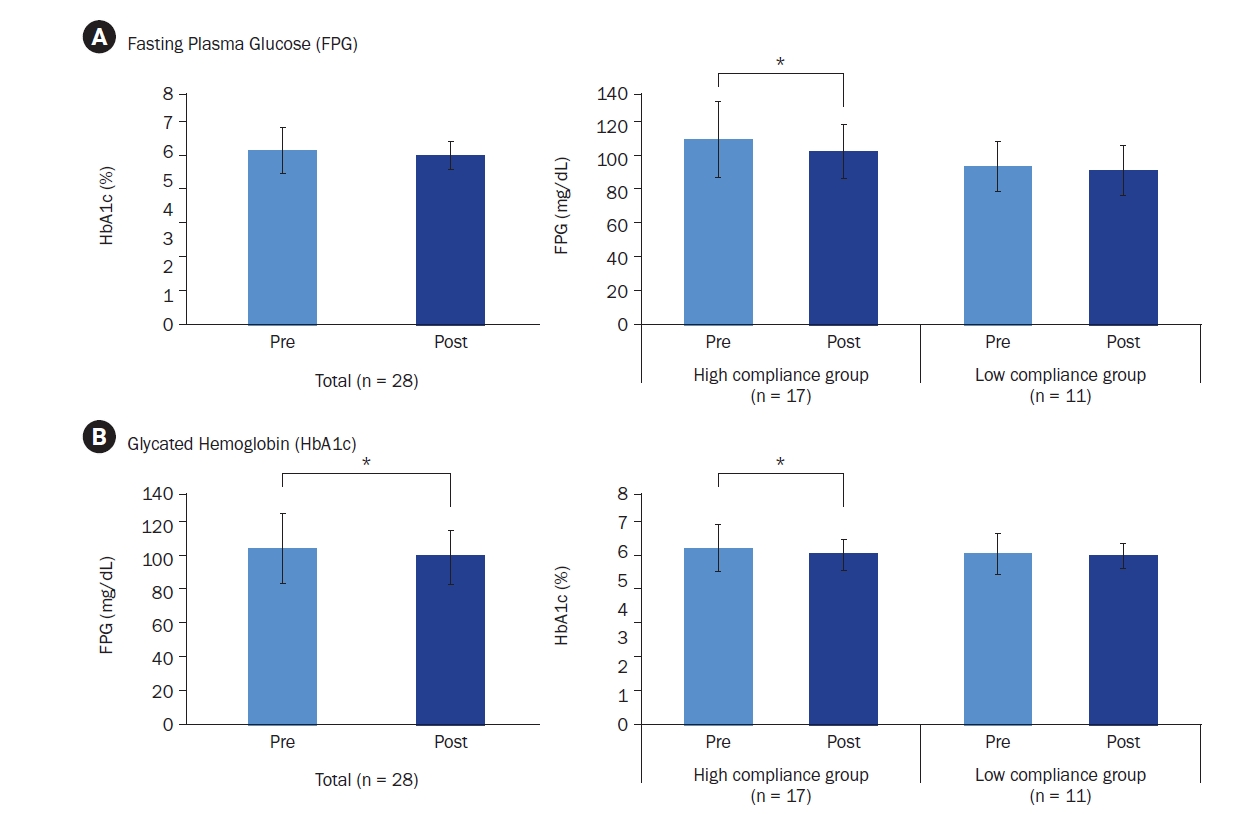
-
 Abstract
Abstract
 PDF
PDF - Objectives
The aim of this study was to assess the impact of a multi-component program, including partially hydrolyzed guar gum (PHGG, Sunfiber®) supplementation, on glycemic control, gut health, and nutritional status to support diabetes prevention and management among Korean adults.
Methods
A single-arm trial was conducted with 29 adults (aged 20-55 years) with fasting plasma glucose (FPG) ≥ 100 mg/dL. Over a six-week period, participants engaged in a multi-component program that incorporated the supplementation of PHGG (Sunfiber®, 12.5 g/day), weekly nutritional coaching, and the use of continuous glucose monitoring devices. The program’s effectiveness was evaluated by measuring FPG and glycated hemoglobin (HbA1c) levels through blood tests conducted before and after the intervention. Improvements in gut health were gauged using the Korean Gut Quotient Measurement Scales, while enhancements in nutritional status were assessed using the Nutrition Quotient (NQ) and surveys that evaluated improvements in gut health and nutritional status.
Results
Participants’ average age was 43.89 years, with approximately 80% being male. Most participants (about 75%) were classified as overweight or obese. After six-weeks, 17 participants who adhered closely to the program (meeting certification criteria) exhibited significant reductions in key blood glucose markers. FPG levels decreased from 113.06 ± 23.16 mg/dL to 106.24 ± 16.33 mg/dL (P < 0.05), and HbA1c levels decreased from 6.08% ± 0.81% to 5.87% ± 0.53% (P < 0.05). The NQ evaluation revealed significant increases in comprehensive nutrition scores, and in the balance and practice domain scores for all participants (P < 0.05). Furthermore, in the gut health survey, approximately 82.1% of all participants reported experiencing positive changes.
Conclusion
Among adults with elevated FPG levels, a multi-component intervention program that included PHGG (Sunfiber®) supplementation, structured dietary management, and the use of health-monitoring devices showed significant benefits in improving glycemic control, overall nutritional status, and gut health. Trial Registration: Clinical Research Information Service Identifier: KCT0010049. -
Citations
Citations to this article as recorded by- Comparative analysis of dietary and lifestyle habits according to the prediabetic status in young adults
Joungyoon Seo, SeongHee Shin, Yuri Kim, Yoo Kyoung Park
Journal of Nutrition and Health.2025; 58(5): 468. CrossRef - Partially Hydrolyzed Guar Gum Combined with a Low-Fat Diet Ameliorates Type 2 Diabetes Mellitus via Modulating Gut Microbiota and Fecal Metabolites
Zhiqiang Cao, Hongxia Li, Quantao Cai, Li Chen, Liangzhong Liu, Yuhan Tang, Zhe Zhu, Ping Yao
Nutrients.2025; 17(23): 3746. CrossRef
- Comparative analysis of dietary and lifestyle habits according to the prediabetic status in young adults
- 7,503 View
- 44 Download
- 2 Crossref

- [Korean]
- Biochemical characteristics, nutrient intakes, and chronic disease risk according to the dietary fat energy ratio in middle-aged Korean: a cross-sectional study using data from the 7th (2016–2018) Korean National Health and Nutrition Examination Survey
- Ga-Hyeon Jeong, Sook-Bae Kim
- Korean J Community Nutr 2024;29(6):528-540. Published online December 31, 2024
- DOI: https://doi.org/10.5720/kjcn.2024.00304
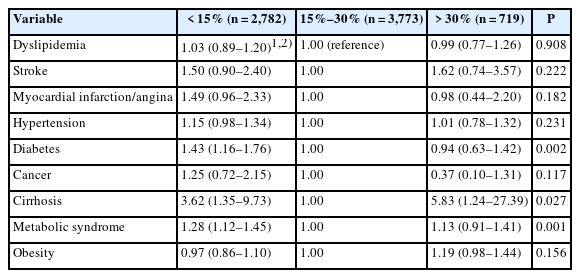
-
 Abstract
Abstract
 PDF
PDF - Objectives
This study aimed to examine health-related characteristics and chronic disease risk in middle-aged Koreans based on their fat energy intake ratio.
Methods
We analyzed data from 7,274 Koreans aged 40–64 years using the 7th (2016–2018) Koreans National Health and Nutrition Examination Survey. Participants were classified into three groups based on their fat energy intake ratio: insufficient (< 15%), adequate (15%–30%), and excessive (> 30%). We assessed their socio-demographic characteristics; lifestyle characteristics; biochemical characteristics; quantitative and qualitative nutrient intakes, measured using dietary reference intakes for Koreans and index of nutrition quality (INQ); and chronic disease risk.
Results
Significant differences were observed between the groups in age, gender, income, education, and residence region. The insufficient group had the highest proportion of older adults, male, lower income, rural residents, and lower education levels. The groups differed significantly in lifestyle characteristics, with the insufficient group having the highest rates of no walking, heavy drinking, smoking, and poor subjective health perception. Biochemical characteristics in the insufficient group exhibited the lowest levels for fasting blood glucose, hemoglobin A1c, and triglycerides. Significant differences were found in both the quantitative and qualitative intake of nutrients. The insufficient group had the lowest intake of most nutrients except fiber, whereas the excessive group had the lowest fiber intake. Based on the INQ, vitamin A and Ca were the lowest in the insufficient group, and vitamin C and folic acid were the lowest in the excessive group. The risk of diabetes mellitus and metabolic syndrome was highest in the deficient group, and the risk of liver cirrhosis was highest in the excessive group.
Conclusion
Insufficient or excessive fat energy intake ratio negatively affects nutrient intake and chronic disease risk. Fat energy intake of 15%–30% is important for improving nutrient intake and managing chronic diseases, such as diabetes mellitus, metabolic syndrome, and liver cirrhosis. We suggest that education and an appropriate social environment are necessary to ensure this fat energy intake. -
Citations
Citations to this article as recorded by- Study on the Optimization of Manufacturing Conditions for Traditional Potato Bugak Using Response Surface Methodology
Yu Hyeon Jo, Jeong Ok Rho
Journal of the East Asian Society of Dietary Life.2025; 35(1): 60. CrossRef - Nutritional risk assessment using estimated usual nutrient intake in Korean adults: analysis of the 8th (2019–2021) Korea National Health and Nutrition Examination Survey data
Woojin Byeon, Cho-il Kim, Sung Ok Kwon, Jihyun Yoon, Linxi Huang
Nutrition Research and Practice.2025; 19(5): 799. CrossRef
- Study on the Optimization of Manufacturing Conditions for Traditional Potato Bugak Using Response Surface Methodology
- 1,571 View
- 51 Download
- 2 Crossref

- [Korean]
- The needs and prioritization of nutrition and dietary support for individuals with disabilities: an exploratory study
- Jong Eun Park, Yu Jin Kim, So Young Kim, Jong Hyock Park
- Korean J Community Nutr 2024;29(5):431-443. Published online October 31, 2024
- DOI: https://doi.org/10.5720/kjcn.2024.00009
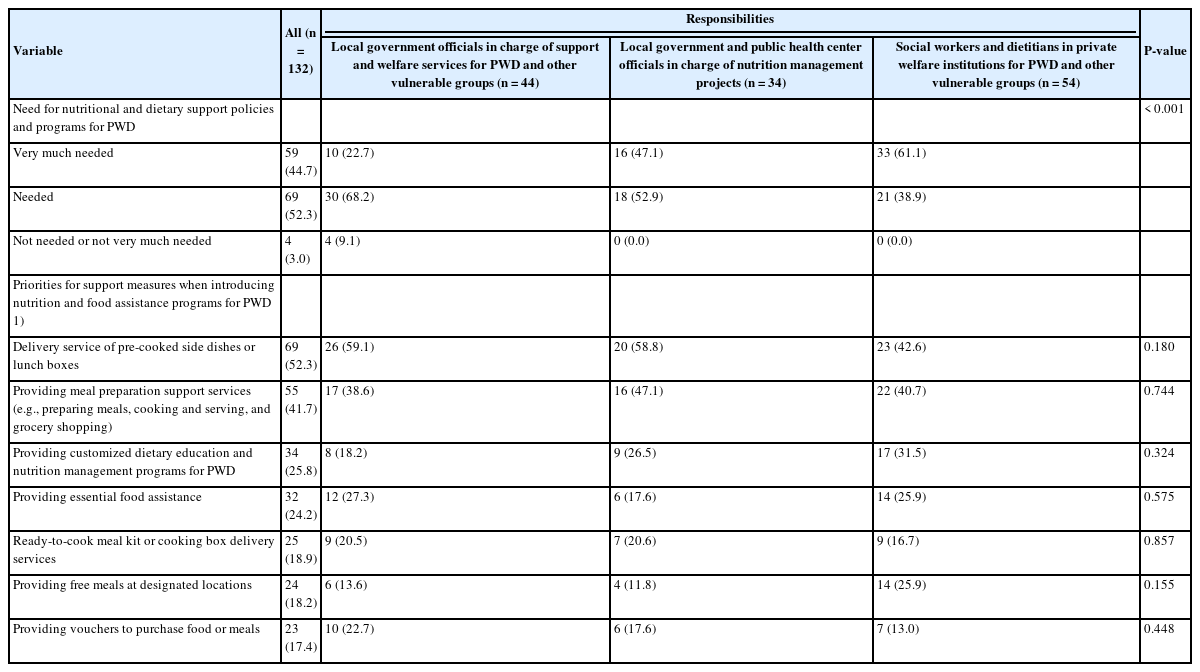
-
 Abstract
Abstract
 PDF
PDF - Objectives
Based on a survey of officers, social workers, and dietitians involved in managing nutrition and welfare policies or projects for vulnerable groups in local governments or private welfare institutions, this study aimed to assess the need for nutritional and dietary support policies and programs for persons with disabilities (PWD), as well as to identify appropriate support measures. Methods: An online survey was conducted from March 2 to 15, 2021. The survey included 20 questions exploring perspectives on the nutritional status of PWD, their need for nutritional and dietary support policies and programs, and the prioritization of appropriate support measures. A total of 132 responses were analyzed. Results: Approximately 68.9% of the respondents rated the nutritional status of PWD as “bad” or “very bad.” A substantial number identified “difficulty in purchasing ingredients, cooking, and preparing meals independently due to disability,” and “limited knowledge about nutrition and recipes necessary for maintaining a healthy and balanced diet” as the primary challenges in the dietary and nutritional management of this population. Additionally, 97.0% of the respondents deemed that the introduction of nutritional and dietary support policies and programs for PWD was “needed” or “very much needed.” Priority strategies to implement and strengthen these policies and systems included the “development of customized programs and services tailored to the needs and demands of the target population” and the “establishment of a dedicated department with specialized personnel.” Conclusion: Comprehensive nutritional and dietary support policies and programs should be actively implemented to ensure a healthy and stable diet for PWD, tailored to meet their actual needs and demands. -
Citations
Citations to this article as recorded by- Development of a standard nutrition management model algorithm for personalized care in social welfare facilities for the disabled
Su-Jin Lee, Ji-Won Kang, Sil Ah Kim, Kirang Kim, Sohyun Park, Jieun Oh, Hyunjoo Ryou, Ji-Yun Hwang
Journal of Nutrition and Health.2025; 58(5): 498. CrossRef - Factors associated with nutritional risk among disabled persons in the Republic of Korea: a cross-sectional study using 2020 Disability and Life Dynamics Panel
Seong-Ah Kim, Seul Ki Choi
Korean Journal of Community Nutrition.2025; 30(5): 364. CrossRef
- Development of a standard nutrition management model algorithm for personalized care in social welfare facilities for the disabled
- 2,649 View
- 117 Download
- 2 Crossref

- [English]
- Eating habits and dietary supplement utilization according to food-related lifestyle among Korean adults: a cross-sectional study
- EunJung Lee, Jin A Jang, Ji-Myung Kim
- Korean J Community Nutr 2024;29(4):253-264. Published online August 31, 2024
- DOI: https://doi.org/10.5720/kjcn.2024.00017
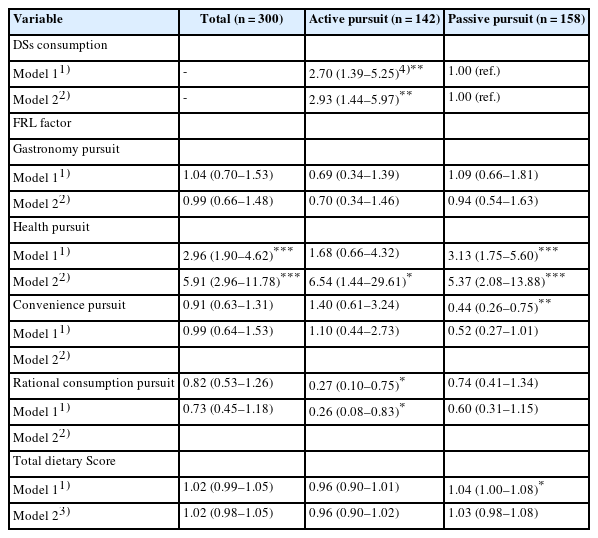
-
 Abstract
Abstract
 PDF
PDF - Objectives
This study investigated the association between eating habits and the utilization of dietary supplements (DSs) according to food-related lifestyle (FRL) among Korean adults. Methods: This study included a total of 300 participants (150 men and 150 women) in their 20s to 60s living in Seoul and Gyeonggi Province. We identified two groups by factor and cluster analysis: an ‘active pursuit’ group and a ‘passive pursuit’ group. Differences in eating habits and DS utilization between the two groups were analyzed by chi-square test and t-test. Logistic regression analysis was used to analyze the effect of variables on DS consumption according to FRL. Results: There were significant differences between the two groups in terms of age, alcohol drinking frequency, total dietary score, change in DS consumption after coronavirus disease 2019, and current DS consumption (P < 0.05). The proportion who perceived many health benefits of DSs was higher in the ‘active pursuit’ group than in the ‘passive pursuit’ group (P = 0.003). The most commonly consumed type of DSs was multivitamins & minerals for the ‘active pursuit’ group, and omega-3 fatty acids for the ‘passive pursuit’ group. The ‘an active pursuit’ group consumed DSs 2.93 times more (95% confidence interval [CI]: 1.44–5.97) compared to the ‘passive pursuit’ group, after adjusting for confounders. In the ‘active pursuit’ group, the health pursuit (odds ratio [OR] = 6.54, 95% CI: 1.44– 29.61) and rational consumption pursuit factors (OR = 0.26, 95% CI: 0.08–0.83) were associated with DS consumption, whereas only the health pursuit factor had a significant association (OR = 5.37, 95% CI: 2.08–13.88) within the ‘passive pursuit’ group. However, total dietary score and DSs consumption did not show a relationship. Conclusions: By understanding the consumption characteristics of DSs according to FRL, this can serve as basic data necessary for promoting health through the utilization of DSs and healthy behaviors. -
Citations
Citations to this article as recorded by- Discovering Vitamin-D-Deficiency-Associated Factors in Korean Adults Using KNHANES Data Based on an Integrated Analysis of Machine Learning and Statistical Techniques
Hongryul Ahn, Seungwon Kim, Jinmyung Jung, Chan Park
Nutrients.2025; 17(4): 618. CrossRef - Demographic and behavioral correlation of red ginseng consumption in Korea
DeYu Tian, KeunOh Choi, Yong-ung Kim, YoungJoo Lee
Integrative Medicine Research.2025; : 101287. CrossRef
- Discovering Vitamin-D-Deficiency-Associated Factors in Korean Adults Using KNHANES Data Based on an Integrated Analysis of Machine Learning and Statistical Techniques
- 5,027 View
- 94 Download
- 2 Crossref

- [English]
- Serum branch chain amino acids and aromatic amino acids ratio and metabolic risks in Koreans with normal-weight or obesity: a cross-sectional study
- Ji-Sook Park, Kainat Ahmed, Jung-Eun Yim
- Korean J Community Nutr 2024;29(3):212-221. Published online June 30, 2024
- DOI: https://doi.org/10.5720/kjcn.2024.29.3.212

-
 Abstract
Abstract
 PDF
PDF - Objectives
Metabolic disease is strongly associated with future insulin resistance, and its prevalence is increasing worldwide. Thus, identifying early biomarkers of metabolic-related disease based on serum profiling is useful to control future metabolic disease. Our study aimed to assess the association of serum branched chain amino acids (BCAAs) and aromatic amino acids (AAAs) ratio and metabolic disease according to body mass index (BMI) status among Korean adults.
Methods
This cross-sectional study included 78 adults aged 20–59 years in Korea. We compared serum amino acid (AA) levels between adults with normal-weight and adults with obesity and investigated biomarkers of metabolic disease. We examined serum AA levels, blood profile, and body composition. We also evaluated the association between serum AAs and metabolic-related disease.
Results
The height, weight, BMI, waist circumference, hip circumference, waist-hip-ratio, body fat mass, body fat percent, skeletal muscle mass, systolic blood pressure, and diastolic blood pressure were higher in the group with obesity compared to normal weight group. The group with obesity showed significantly higher levels of BCAA, AAA, and BCAA and AAA ratio. Further, BCAA and AAA ratio were significantly positively correlated with triglyceride, body weight, and skeletal muscle mass. The evaluation of metabolic disease risks revealed an association between the ratios of BCAAs and AAAs, hypertension, and metabolic syndrome.
Conclusions
Our study is showed the associations between BCAA and AAA ratio, obesity, and obesity-related diseases using various analytical approaches. The elevated BCAA and AAA ratio could be early biomarkers for predicting future metabolic diseases in Korean population. -
Citations
Citations to this article as recorded by- The Role of Aromatic Amino Acids in Polycystic Ovary Syndrome through Patients’ Blood Metabolic Profiling: A Systematic Review of the Past Five Years
Apostolos Gkantzos, Stavros Kalogiannis, Olga Deda
Journal of Proteome Research.2025; 24(5): 2208. CrossRef - Current Data on the Role of Amino Acids in the Management of Obesity in Children and Adolescents
Diana Zamosteanu, Nina Filip, Laura Mihaela Trandafir, Elena Ţarcă, Mihaela Pertea, Gabriela Bordeianu, Jana Bernic, Anne Marie Heredea, Elena Cojocaru
International Journal of Molecular Sciences.2025; 26(15): 7129. CrossRef
- The Role of Aromatic Amino Acids in Polycystic Ovary Syndrome through Patients’ Blood Metabolic Profiling: A Systematic Review of the Past Five Years
- 2,213 View
- 26 Download
- 2 Crossref

- [English]
- Exploring factors of nutrition teachers’ intentions for sustainable dietary education in South Korea: an application of the theory of planned behavior
- Eunseo Yang, Borham Yoon
- Korean J Community Nutr 2024;29(2):114-128. Published online April 24, 2024
- DOI: https://doi.org/10.5720/kjcn.2024.29.2.114
-
 Abstract
Abstract
 PDF
PDF - Objectives
The purpose of this study was to investigate the perception of nutrition teachers and the factors influencing their intention toward sustainable dietary education utilizing the theory of planned behavior (TPB).
Methods
The self-administered online survey was completed by nutrition teachers in Jeollanam-do, South Korea. A total of 151 valid questionnaires were analyzed. Factor analysis and multiple regressions were employed to test the research model.
Results
The study findings demonstrated that all TPB variables significantly influenced the sustainable dietary educational intention, with the degree of influence ranking as follows: external perceived behavioral control (β = 0.417), attitude (β = 0.240), internal perceived behavioral control (β = 0.207), and subjective norms (β = 0.181). For external perceived behavioral control, nutrition teachers and elementary schools exhibited higher levels compared to dietitians and middle/high schools, respectively. The participants in sustainable dietary education training programs exhibited a higher level of internal perceived behavioral control compared to those who did not participate. The highest perception levels were reported for attitude (4.26), followed by subjective norms (4.02), internal perceived behavioral control (3.67), and external perceived behavioral control (3.20).
Conclusions
This study affirmed that the TPB variables elucidated the sustainable dietary educational intentions of nutrition teachers. The significant impacts of external and internal perceived behavioral control, attitude, and subjective norms on educational intentions were confirmed. Consequently, proactive support from schools and governments is essential to enhance the facilitating factors and mitigate the barriers toward sustainable dietary education in schools. -
Citations
Citations to this article as recorded by- Behavioral intention toward planetary health diet among adult users of government worksite cafeterias in Seoul, South Korea: a mixed-methods study based on the theory of planned behavior and focus groups interviews
Ji-Won Kang, Su-Jin Lee, Sil-Ah Kim, Ji-Yun Hwang
Korean Journal of Community Nutrition.2025; 30(3): 224. CrossRef - An educational needs analysis of sustainable dietary education for nutrition teachers: an application of the IPA, Borich needs assessment and The locus for focus model
Eunseo Yang, Borham Yoon
Korean Journal of Community Nutrition.2024; 29(5): 372. CrossRef
- Behavioral intention toward planetary health diet among adult users of government worksite cafeterias in Seoul, South Korea: a mixed-methods study based on the theory of planned behavior and focus groups interviews
- 1,652 View
- 39 Download
- 2 Crossref

- [Korean]
- Knowledge on complementary foods of mothers with young children and their perception of convenience complementary foods
- Yoojeong Joo, Jihyun Yoon, Linxi Huang, Youngmin Nam
- Korean J Community Nutr 2024;29(1):16-33. Published online February 29, 2024
- DOI: https://doi.org/10.5720/kjcn.2024.29.1.16
- Correction in: Korean J Community Nutr 2024;29(2):171
-
 Abstract
Abstract
 PDF
PDF - Objectives
The purpose of this study was to examine mothers’ knowledge levels on complementary foods and their perception of convenience complementary foods.
Methods
An online survey was conducted with mothers aged 20–49 years who had purchased convenience complementary foods and had a preschool child aged 4 months or older. The respondents were categorized into 3 groups based on their knowledge scores: low- (0–50 points), mid- (55–65 points), and high- (70–100 points) knowledge groups.
Results
The average score of mothers’ knowledge on complementary foods was 58.8 out of 100 points. Working mothers were found to have lower levels of knowledge compared to mothers who were housewives. Only 1/4 of responding mothers had educational experience on complementary foods. Mothers expressed a desire for information on the types of complementary foods (72.2%) and the intake amounts (60.3%) corresponding to each phase of their child’s development. Multivariate analysis of variance revealed significant differences in health (P = 0.002), variety (P = 0.039), and hygiene (P = 0.041) among the factors taken into consideration when purchasing convenience complementary foods according to the mothers’ knowledge levels. Mothers in the high-knowledge group placed a greater importance on ‘balanced nutrition’ (P = 0.022) and ‘hygienic cooking’ (P = 0.010) compared to mothers in the low-knowledge group. The results of the modified importance-performance analysis, which compared the importance and performance of the factors taken into consideration when purchasing convenience complementary foods, highlighted the need for efforts in ‘health,’ ‘hygiene,’ and ‘price,’ while also indicating an excessive effort in ‘convenience.’
Conclusions
This study suggests expanding relevant education programs to enhance mothers’ knowledge on complementary foods, especially for working mothers. In the industry, marketing strategies for complementary food products could be developed that align with the needs of mothers, focusing on health, hygiene, and price. -
Citations
Citations to this article as recorded by- Development and Evaluation of a Nutrition Education Website for the Prevention and Management of Childhood Obesity
Miyong Yon, Chan Park, Kwan-Hee Yoo, Taisun Hyun
Korean Journal of Community Nutrition.2012; 17(4): 390. CrossRef - Breakfast Skipping and Related Factors in Children in Poverty
Kyung Ja June, Jin-Young Kim, Seungmi Park, Ji Yun Lee
Journal of Korean Academy of Community Health Nursing.2011; 22(2): 204. CrossRef
- Development and Evaluation of a Nutrition Education Website for the Prevention and Management of Childhood Obesity
- 3,530 View
- 73 Download
- 2 Crossref

Review
- [Korean]
- Current status of nutrition education media and its utilization in providing customized nutrition information for older adults in Korea: a scoping review based on the transtheoretical model and food literacy
- Seojin Yun, Jiwon An, Kirang Kim
- Korean J Community Nutr 2025;30(3):175-182. Published online June 30, 2025
- DOI: https://doi.org/10.5720/kjcn.2025.00094
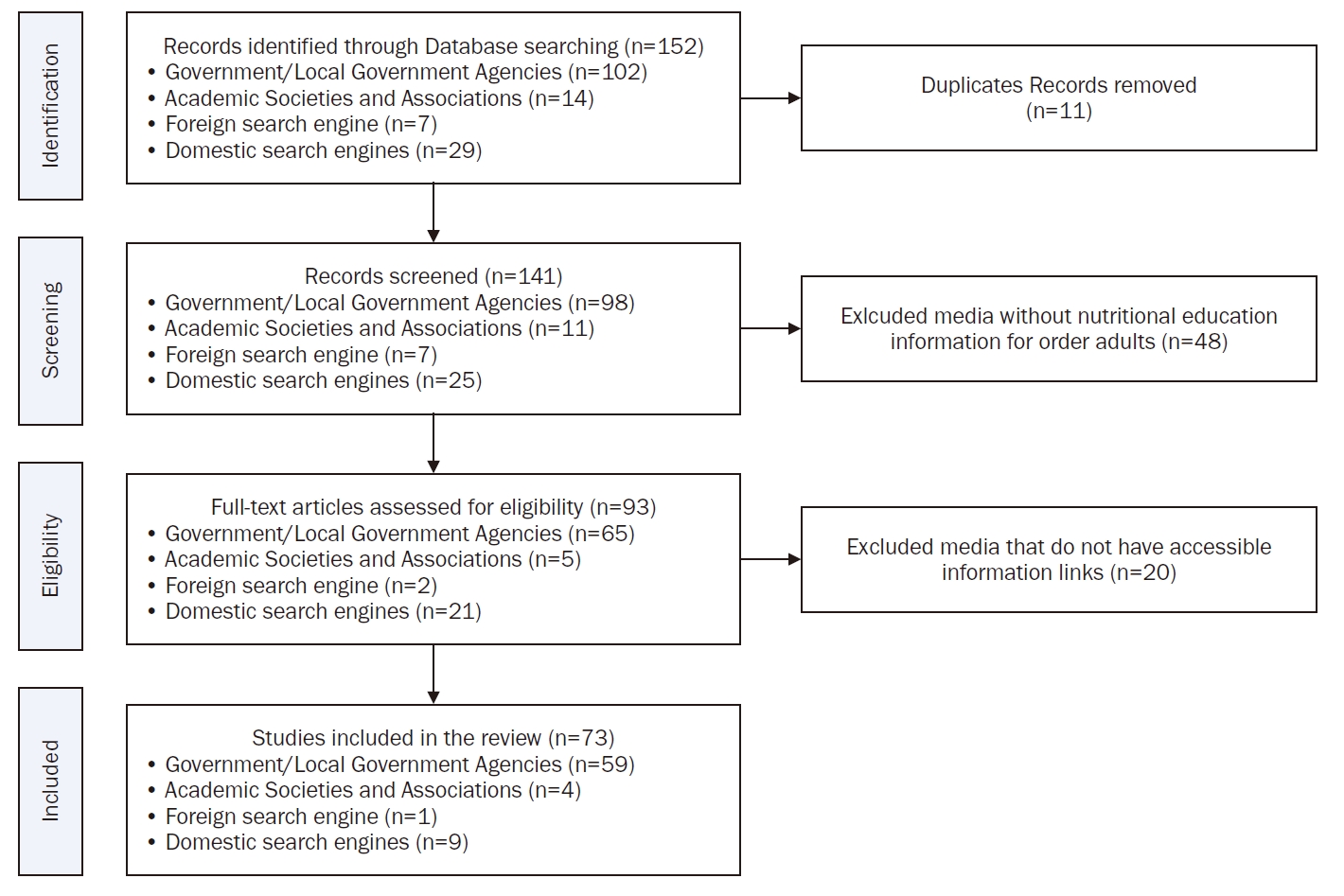
-
 Abstract
Abstract
 PDF
PDF Supplementary Material
Supplementary Material - Objectives
This study analyzes the status of nutrition education media among Korean older adults based on the transtheoretical model (TTM) and their food literacy to propose effective strategies for the development and utilization of educational media.
Methods
A literature review was conducted using The Joanna Briggs Institute (JBI) protocol. The literature search was performed using government and local government agency websites, as well as those of affiliated institutions, health and nutrition-related academic societies, and academic search engines. A total of 144 studies were identified, and after a cross-evaluation by two reviewers based on the literature selection criteria, 73 studies were included in the final analysis.
Results
Among the types of nutrition education media, card news had the highest proportion, followed by video media. The development and distribution of nutrition education media for older adults were primarily carried out by government and local government agencies, as well as related affiliated institutions, accounting for 80.8% (n = 59) of the total. When nutrition education topics in the media were categorized according to the stages of behavior change in the TTM, the largest proportion, 64.6% (n = 61), was applicable to the precontemplation and contemplation stages. When categorized by food literacy domains, all topics fell under the categories of nutrition and safety.
Conclusion
Nutrition education media for older adults were found to be primarily focused on knowledge acquisition and information delivery, making them mostly applicable to the precontemplation and contemplation stages of behavior change. The concept of food literacy addressed in the different types of media was limited to the domains of nutrition and safety, with no content covering the cultural and relational domains or the social and ecological domains. For tailored nutrition education, it is necessary to develop diverse educational materials that comprehensively reflect each stage of the TTM and all aspects of food literacy. -
Citations
Citations to this article as recorded by- Toward the development of a digital self-nutrition management education program for elderly: findings from focus groups study
Hae-song Yoo, Jin-myong Lee, Min-sun Jeon
Korean Journal of Community Nutrition.2025; 30(6): 431. CrossRef
- Toward the development of a digital self-nutrition management education program for elderly: findings from focus groups study
- 1,752 View
- 82 Download
- 1 Crossref

Research Articles
- [English]
- Healthy eating intentions among adults in China: a cross-sectional study of northern and southern regions and city tiers based on the theory of planned behavior
- Yi Jiang, Ji-Yun Hwang
- Korean J Community Nutr 2025;30(2):114-126. Published online April 29, 2025
- DOI: https://doi.org/10.5720/kjcn.2025.00087
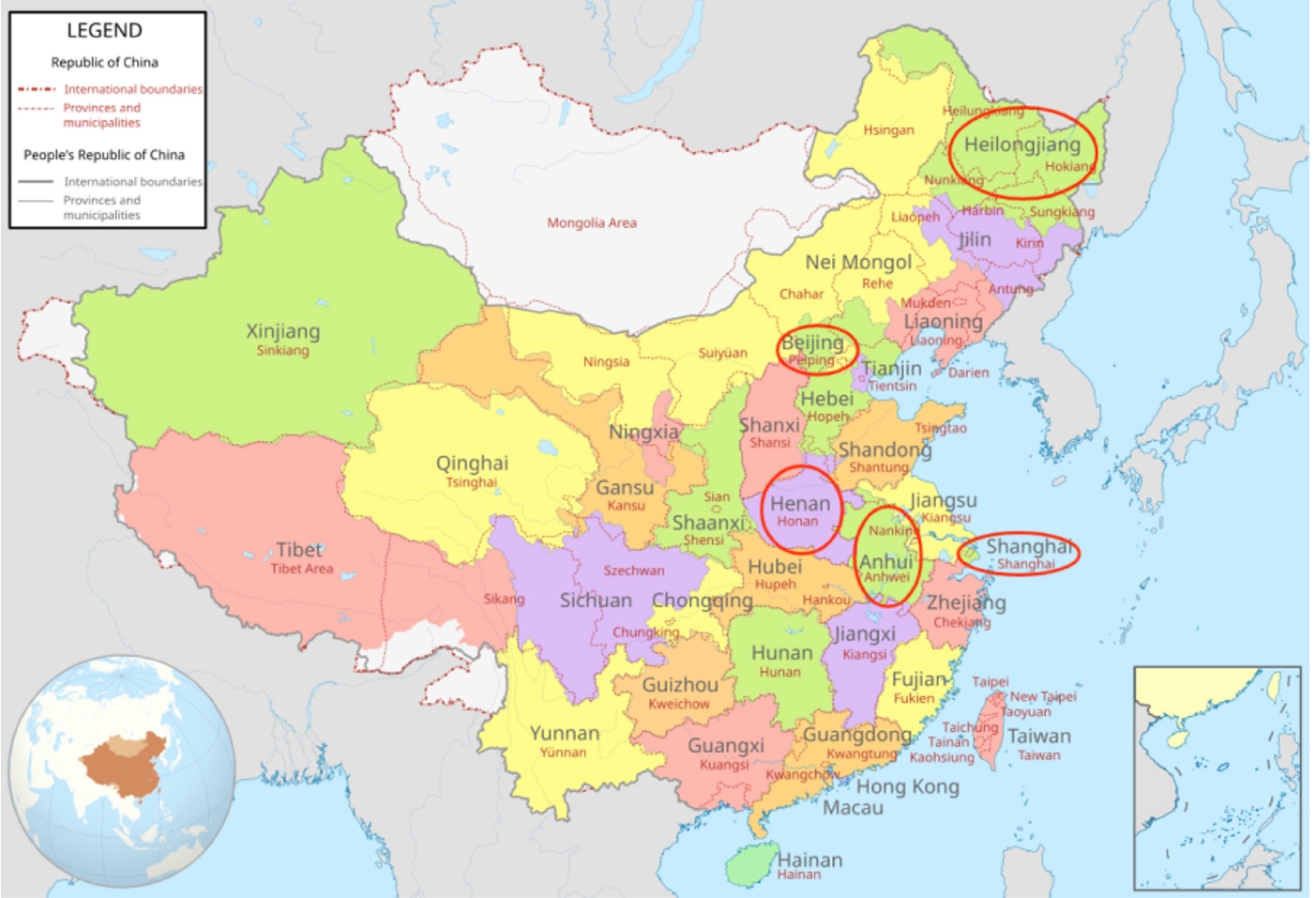
-
 Abstract
Abstract
 PDF
PDF - Objectives
The theory of planned behavior (TPB) has been widely employed to predict healthy eating intentions. Regional differences may affect dietary habits, health status, and personality traits, whereas variations in urbanization influence accessibility to fresh and healthy food, thereby impacting TPB components. This study aimed to explore whether regional differences between northern and southern China including city-tier development are associated with healthy eating intentions among Chinese adults.
Methods
The study included data from 2,114 Chinese adults aged 19–64 years collected between 2019 and 2023. Participants were categorized by geographic region (north or south) and city-tier status (first-tier or other).
Results
Compared to individuals from northern first-tier cities, those from southern regions exhibited stronger attitudes, perceived behavioral control (PBC), and intention to eat healthily. Participants from other cities in the north had more positive attitudes, subjective norms, PBC, and intentions to participate in healthy eating. Furthermore, residents of southern cities revealed weaker subjective norms than those of cities in the north. The adjusted odds ratio (OR) for compliance with intention to engage in healthy eating was higher among participants from other cities in both the north and south compared to those from northern first-tier cities (northern other cities: OR = 2.43, 95% confidence interval [CI]: 1.49–3.97, P < 0.001; southern other cities: OR = 1.95, 95% CI: 1.08–3.51, P = 0.027). No significant differences existed among the subjects from first-tier cities according to their geographic regions. These trends remained consistent even after including the interaction term between geographic regions and city-tier classification.
Conclusion
These findings underscore the complexity of regional variations influencing dietary intentions and indicate that tailored health promotion strategies should incorporate regional characteristics. Future research should explore underlying factors, including regional cultural influences, to better inform policies and interventions. -
Citations
Citations to this article as recorded by- Beyond taste: Unpacking the drivers of plant-based diet adoption
Md. Asaduzzaman Babu
Food and Humanity.2025; 5: 100779. CrossRef
- Beyond taste: Unpacking the drivers of plant-based diet adoption
- 1,702 View
- 31 Download
- 1 Crossref

- [Korean]
- Effects of night eating on oral health characteristics and symptoms of poor oral health in adolescents: a cross-sectional study using the 18th Korea Youth Risk Behavior Survey
- Seung–Hee Hong
- Korean J Community Nutr 2025;30(2):150-162. Published online April 29, 2025
- DOI: https://doi.org/10.5720/kjcn.2025.00038

-
 Abstract
Abstract
 PDF
PDF - Objectives
To determine the association between night eating habits and oral health in adolescents.
Methods
Data from the 18th Korea Youth Risk Behavior Survey conducted in 2022 were analyzed. The study included 51,850 middle and high school students and assessed the frequency of night eating per week, dietary habits, oral health characteristics, and factors affecting the presence of symptoms of poor oral health.
Results
Almost thirty-seven percent (36.6%) of Korean adolescents have eaten at night one to two times per week and 23.0% more than three times per week. An increased frequency of night eating was associated with poor dietary habits. Adolescents who consumed more at night were less likely to have breakfast, drink water, and eat fruit, while their consumption of fast food, sweet drinks, and high-caffeine drinks increased (P < 0.001). An increased frequency of night eating was also associated with poor oral health. In a logistic regression analysis, more frequent night eaters were significantly less likely to brush their teeth at least three times per day (odds ratio [OR], 0.78; 95% confidence interval [CI], 0.75–0.82; P for trend < 0.001), and brush their teeth before going to sleep (OR, 0.70; 95% CI, 0.65–0.75; P for trend < 0.001), while they were more likely to experience sealant (OR, 1.19; 95% CI, 1.13–1.26). More frequent night eaters were significantly more likely to have tooth fracture (OR, 1.41; 95% CI, 1.30–1.53; P for trend < 0.001), tooth pain when eating (OR, 1.59; 95% CI, 1.50–1.67; P for trend < 0.001), toothache (OR, 1.60; 95% CI, 1.52–1.70), and bad breath (OR, 1.51; 95% CI, 1.43–1.60).
Conclusion
Our findings suggest that frequent night eating is linked to symptomatically poor oral health in adolescents. Therefore, oral health education programs related to dietary habits are necessary to reduce the potential of night eating to negatively influence dietary habits and oral health. -
Citations
Citations to this article as recorded by- Association between Sleep Quality and Perceived Oral Health among Adolescents: Analysis of the 2024 Korea Youth Risk Behavior Survey
Bo Young Park, Eun Bi Sim
Journal of Dental Hygiene Science.2025; 25(4): 370. CrossRef
- Association between Sleep Quality and Perceived Oral Health among Adolescents: Analysis of the 2024 Korea Youth Risk Behavior Survey
- 2,466 View
- 58 Download
- 1 Crossref

- [English]
- Understanding the charactersitics and types of single-person households based on food purchase frequencies in Korea: a cross-sectional study using the 2023 Consumer Behavior Survey for Foods
- So-Yun Kim, Youngmin Nam, Jong-Youn Rha, Haerang Lee
- Korean J Community Nutr 2025;30(1):27-39. Published online February 28, 2025
- DOI: https://doi.org/10.5720/kjcn.2025.00031

-
 Abstract
Abstract
 PDF
PDF - Objectives
This study investigated the differences in food purchase frequency among single-person households by gender and age group and explored the characteristics of single-person household groups according to their food purchase patterns.
Methods
Utilizing data from the 2023 Consumer Behavior Survey for Foods conducted by the Korea Rural Economic Institute, this study examined food purchase frequencies among 966 single-person households. Data were analyzed using Rao-Scott chi-square tests, ANCOVA, ANOVA, and K-modes hierarchical cluster analysis.
Results
Significant differences were observed in the food purchase frequencies of single-person households for fresh and convenient food. Women displayed higher purchase frequencies for fish, vegetables, and fruits, whereas men showed higher purchase frequencies for convenient foods (P < 0.005). Single-person households aged 39 years and younger exhibited lower purchase frequencies for vegetables (P < 0.005) and fish (P < 0.001) and substantially higher frequencies of convenient food purchases (P < 0.001). Additionally, this study identified three distinct single-person household groups based on food purchase pattern: the “nutrition-conscious” group, which exhibited high purchase frequency for fresh foods; the “convenience-seeking” group, which showed high purchase frequency for all types of convenient foods; and the “passive food consumer” group, which displayed relatively low purchase frequency for both fresh foods and convenient foods. The socio-demographic characteristics of single-person households differed significantly across these three groups, with the “passive food consumer” group and “convenience-seeking” group exhibiting lower healthy eating competency (MN(nutrition-conscious group) = 3.68, MP(passive-food-consumer group) = 3.40, MC(convenience-seeking group) = 3.52, P < 0.001), safe eating competency (MN = 3.87, MP = 3.57, MC = 3.77, P < 0.001), and satisfaction (MN = 3.36, MP = 3.23, MC = 3.25, P = 0.04) than the “nutrition-conscious” group.
Conclusion
This study underscores the need for targeted nutrition programs to address the unique needs of single-person households depending on their characteristics. Specifically, this study highlights the importance of targeted interventions for “convenience-seeking” and “passive food consumer” to promote dietary competency and encourage healthy dietary behavior. -
Citations
Citations to this article as recorded by- Secular trends in dietary patterns among Korean adults: using data from the 2007–2022 Korea National health and nutrition examination survey
Eunyoung Tak, Juhae Kim, Heejin Lee, Minji Kang
Nutrition Journal.2025;[Epub] CrossRef
- Secular trends in dietary patterns among Korean adults: using data from the 2007–2022 Korea National health and nutrition examination survey
- 11,000 View
- 92 Download
- 1 Crossref

- [Korean]
- Development and applicability evaluation of a nutrition education program for residents and users of disability social welfare facilities in Korea: a mixed-methods study
- Jin-kyung Kim, Kyoung-min Lee, Min-sun Jeon
- Korean J Community Nutr 2025;30(1):64-74. Published online February 28, 2025
- DOI: https://doi.org/10.5720/kjcn.2025.00017
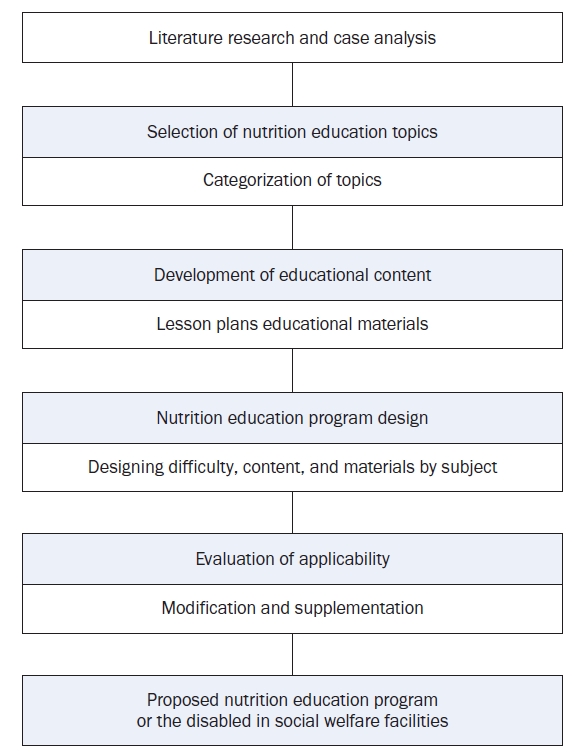
-
 Abstract
Abstract
 PDF
PDF - Objectives
This study aimed to develop a nutrition education program based on social cognitive theory to promote the health of individuals using facilities for people with disabilities. It also sought to evaluate the applicability of the educational materials through assessments by counselors at the Social Welfare Food Service Management Support Center.
Methods
A group of six experts developed the program based on a needs assessment of nutrition education in facilities for individuals with disabilities. Applicability was evaluated through an online survey of 26 counselors from Social Welfare Food Service Management Support Centers nationwide in July 2023, and the results were analyzed.
Results
The nutrition education program includes a basic course on personal hygiene, dining etiquette, picky eating prevention, and obesity management. The advanced course covers dietary management for chronic diseases, such as meal planning for hypertension, diabetes management, and dietary principles for dysphagia. Additionally, lecture PPTs, individual activity sheets, and experiential teaching aids were developed. Applicability evaluations showed high scores, with the teaching-learning plan and PPT averaging 4.15 and the experiential teaching aids scoring 4.17, all above 4.0.
Conclusion
This study developed a nutrition education program for individuals with disabilities and assessed its applicability and usability. Implementing this program in disability welfare institutions could enhance health promotion and improve the quality of life for individuals with disabilities. -
Citations
Citations to this article as recorded by- Development of a standard nutrition management model algorithm for personalized care in social welfare facilities for the disabled
Su-Jin Lee, Ji-Won Kang, Sil Ah Kim, Kirang Kim, Sohyun Park, Jieun Oh, Hyunjoo Ryou, Ji-Yun Hwang
Journal of Nutrition and Health.2025; 58(5): 498. CrossRef
- Development of a standard nutrition management model algorithm for personalized care in social welfare facilities for the disabled
- 2,652 View
- 78 Download
- 1 Crossref

- [Korean]
- Application of a living lab model to an evidence-based reduced-sodium healthy eating practice program in Korea: a pre-post study
- Jung-Hyun Kim, Eugene Shim, Min Sook Kyung, Sooyoun Kwon, Hyoung Su Park, Jae-Heon Kang
- Korean J Community Nutr 2025;30(1):53-63. Published online February 28, 2025
- DOI: https://doi.org/10.5720/kjcn.2024.00346
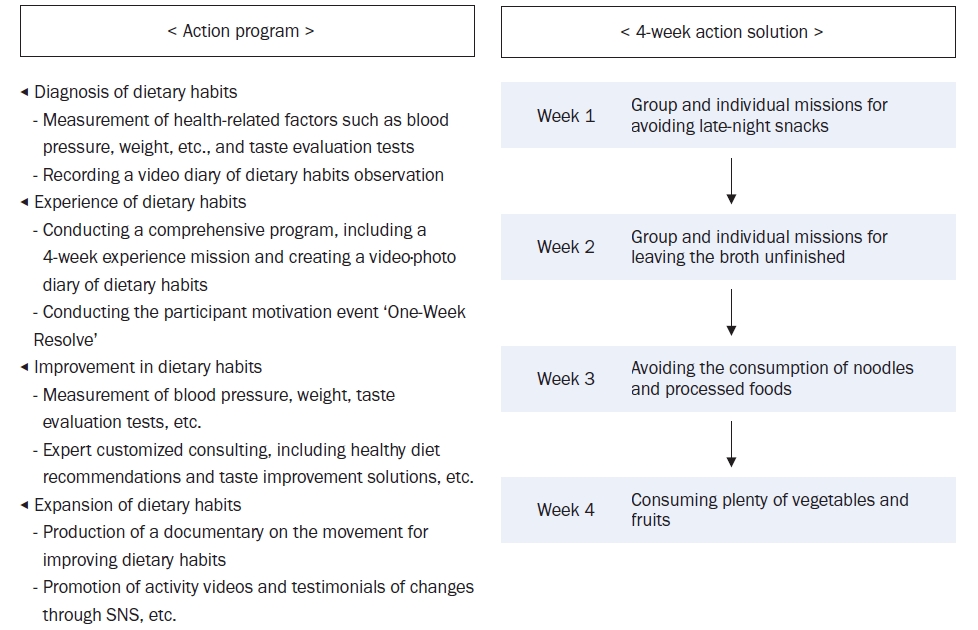
-
 Abstract
Abstract
 PDF
PDF - Objectives
To apply a healthy dietary program with reduced sodium intake, developed using data from the Korea National Health and Nutrition Examination Survey (KNHANES), focusing on the sodium intake level and eating patterns.
Methods
The program was implemented using a living lab model, an open innovation ecosystem for user-centered problem-solving. Analysis of the KNHANES data revealed that older age groups had a low energy intake but a high sodium intake, particularly among those who frequently dined out. The program was designed to improve sodium-reduction literacy and enhance practical competency. Over four weeks, 40 participants tracked their dietary intake and worked with a clinical nutritionist through a process of diagnosis, experience, improvement, and expansion. A self-administered survey was conducted before and after the program to assess effectiveness.
Results
Participants were four teenagers (10%), 26 in their twenties (65%), and 10 aged ≥ 30 years (25%), with eight males (20%) and 32 females (80%). Post-program analysis showed significant improvements in sodium-related nutrition knowledge (P < 0.01), with increased agreement on adopting low-sodium intake practices (e.g., interest in sodium content, choosing lower-sodium foods). Nutrient intake analysis showed a decrease in energy, carbohydrates, lipids, and proteins (P < 0.001), with sodium intake decreasing from 3,382.37 mg/d to 2,119.05 mg/d (P < 0.001).
Conclusion
The community-based, living lab model for the sodium-reduction program effectively improved participant sodium-reduction literacy and practical competency, suggesting that step-by-step, autonomous learning, can reduce sodium intake and promote healthier eating habits. -
Citations
Citations to this article as recorded by- Influence of food literacy on short- and long-term healthy eating intentions among adolescent and adult convenience store users: An application of the extended theory of planned behavior
Wonyeong Park, Hae Jin Park, Suah Moon, Jieun Oh
Nutrition Research and Practice.2025; 19(6): 917. CrossRef
- Influence of food literacy on short- and long-term healthy eating intentions among adolescent and adult convenience store users: An application of the extended theory of planned behavior
- 1,838 View
- 56 Download
- 1 Crossref

- [English]
- Food and nutrient intake in pregnant women with singletons or multiples and post-delivery changes in intake in Korea: an observational study
- Cheawon Lee, Dahyeon Kim, Yoon Ha Kim, Myeong Gyun Choi, Jong Woon Kim, Clara Yongjoo Park
- Korean J Community Nutr 2025;30(1):1-15. Published online February 28, 2025
- DOI: https://doi.org/10.5720/kjcn.2024.00325
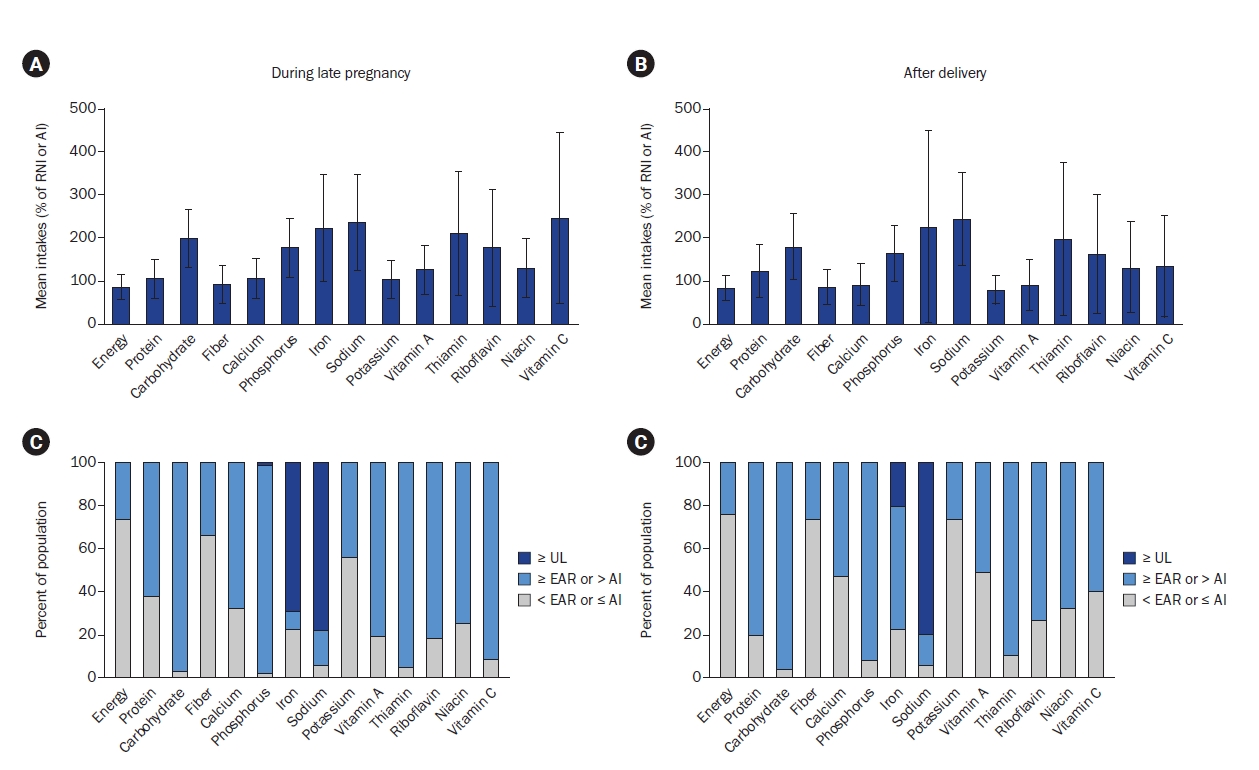
-
 Abstract
Abstract
 PDF
PDF Supplementary Material
Supplementary Material - Objectives
Nutrient intake during pregnancy and lactation is crucial for the health of both mother and offspring. Diet and nutrient metabolism potentially vary according to ethnicity and fetal number; nevertheless, recent studies validating this are inadequate. Furthermore, few studies have tracked changes in intake after delivery. We compared the food and nutrient intakes between pregnant women in Korea carrying singletons and multiples during late pregnancy and assessed their changes through postpartum.
Methods
Ninety-eight pregnant women were recruited from Chonnam National University Hospital between January 2019 and December 2023, and 48 responded to follow-up. Third trimester and postpartum intake were assessed via food frequency questionnaires and supplement questionnaires. Student’s t-test, Mann–Whitney U test, chi-square test, paired t-test or Wilcoxon signed-rank test was performed and adjustments were made for covariates.
Results
Nutrient intake was generally adequate relative to the Dietary Reference Intakes for Koreans, with no differences between singleton- and multiple-pregnancy women. Sixty-six of 98 (67%) pregnant women consumed meat, fish, vegetables, and fruit daily. Dairy intake was low, while the mean iron intake during pregnancy reached 54.2 ± 34.0 mg/d, exceeding the tolerable upper intake level, mainly owing to supplements. Postpartum fruit and vitamin C intake decreased, with no significant differences between breastfeeding and non-breastfeeding women.
Conclusion
Dietary intake did not significantly differ between Korean singleton- and multiple-pregnancy women. Dairy intake was low and iron intake was excessive. Fruit intake decreased after delivery; however, difference in dietary intake according to breastfeeding status was minimal. Nutritional education may be necessary to promote a balanced diet in pregnant and postpartum women. Trial Registration: Clinical Research Information Service Identifier KCT0005118. -
Citations
Citations to this article as recorded by- Placental cadmium and its association with maternal diet and offspring growth in Koreans
Dahyeon Kim, Cheawon Lee, Yoon Ha Kim, Myeong Gyun Choi, Jong Woon Kim, Clara Yongjoo Park
Nutrition Research and Practice.2025; 19(3): 473. CrossRef
- Placental cadmium and its association with maternal diet and offspring growth in Koreans
- 7,263 View
- 64 Download
- 1 Crossref

Research Note
- [English]
- A pilot investigation of a combined food literacy and exercise program for college students: a one-group pre-post intervention study
- Minjeong Jeong, Jinhyun Kim, Dahye Han, Eunjin Jang, Kyoungho Choi, Sohyun Park
- Korean J Community Nutr 2024;29(6):455-466. Published online December 31, 2024
- DOI: https://doi.org/10.5720/kjcn.2024.00248
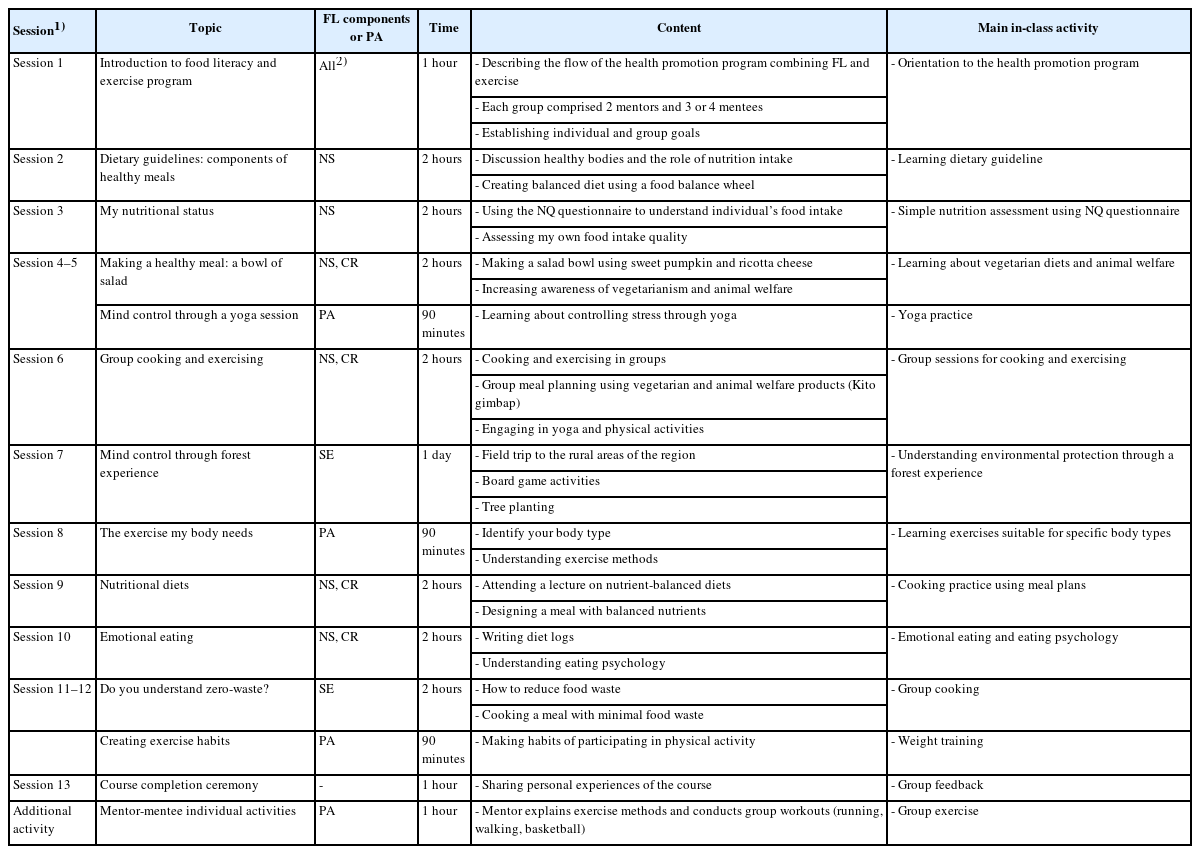
-
 Abstract
Abstract
 PDF
PDF - Objectives
A campus-based intervention to enhance food literacy (FL) and establish exercise habits among college students was developed and the program’s effectiveness was evaluated.
Methods
The 13-session program was developed based on the transtheoretical model and social cognitive theory. Junior and senior students majoring in food and nutrition and physical education were asked to participate as mentors, with freshmen and sophomores from varied majors as mentees. The program encompassed food, nutrition, and exercise lessons including cooking sessions. Data were collected via pre- and post-program surveys using a questionnaire consisting of items on FL and nutrition behaviors and physical fitness measurements.
Results
Among 39 participants (35.9% male, 64.1% female), the overall FL score increased significantly from 64.1 to 70.6 post-program (P = 0.001). Significant increases were observed in the nutrition and safety (P < 0.001), cultural and relational (P = 0.023), and socio-ecological (P = 0.001) domains, as well as knowledge (P = 0.001), self-efficacy (P = 0.013), attitude (P < 0.001), and behavior (P = 0.005) items in three domains of FL. Additionally, meal duration increased significantly (P = 0.007) and sit-up performance among female showed a meaningful change (P = 0.046). Changes in dietary behaviors significantly progressed (P = 0.015) while that in exercise habits approached a marginal significance (P = 0.053) after the intervention.
Conclusion
The results reveal positive changes in FL and some modifications in eating habits, although the program had limited effects on physical activity and fitness measurements. These findings suggest that strategic approaches to foster exercise behavior changes in college students are required. This pilot program can serve as foundational data for improving and expanding multicomponent health promotion programs for this population. -
Citations
Citations to this article as recorded by- The Dragon Fruit Advantage: Exploring University Students’ Experiences and Perceptions of a Targeted Nutrition Education Module
Adelfa Silor, Faith Stephanny C. Silor
Seminars in Medical Writing and Education.2025; 4: 924. CrossRef
- The Dragon Fruit Advantage: Exploring University Students’ Experiences and Perceptions of a Targeted Nutrition Education Module
- 2,408 View
- 53 Download
- 1 Crossref

Research Articles
- [English]
- Trends in growth and nutritional status of Korean toddlers and preschoolers: a cross-sectional study using 2010–2021 Korea National Health and Nutrition Examination Survey data
- Annisa Turridha, Jae Eun Shim
- Korean J Community Nutr 2024;29(6):480-491. Published online December 31, 2024
- DOI: https://doi.org/10.5720/kjcn.2024.00241
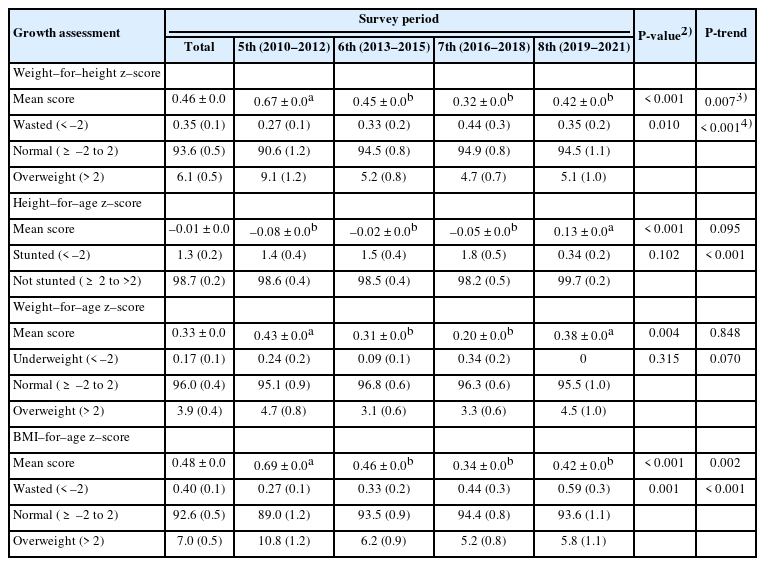
-
 Abstract
Abstract
 PDF
PDF - Objectives
We aimed to analyze trends in growth and nutrient intake patterns in Korean toddlers and preschoolers and generate data for international comparisons of early childhood growth status.
Methods
Overall, 3,661 children aged 1–4 years were included. This study used the data from the 5th–8th Korea National Health and Nutrition Examination Survey. The weight-for-height, height-for-age, weight-for-age, and body mass index-for-age z-scores of the participants were calculated using the World Health Organization 2006 child growth z-score reference cutoff points. The 24-hour recall method was used to determine dietary intake, which was assessed according to the Dietary Reference Intake for Koreans. All statistical analyses were conducted and weighted according to a complex sample design.
Results
Most Korean toddlers and preschoolers demonstrated normal growth, with an increasing trend noted over the survey period. Concurrently, the prevalence of overweight decreased. The mean intake of energy from fat exhibited an upward trend, paralleling that of protein and fat. Conversely, the intake of several essential micronutrients declined. The prevalence of nutritional inadequacy showed significant variation throughout the survey period; the proportion of inadequacy in carbohydrate intake decreased, whereas those of iron, vitamin A, thiamin, niacin, and vitamin C increased.
Conclusion
South Korea is making significant progress in supporting toddlers and preschoolers, as evidenced by consistent increases in the proportion of children with normal growth and decreases in the prevalence of malnutrition. Future research should focus on exploring dietary patterns and analyzing specific food groups that are essential for promoting optimal growth and nutritional status in children. -
Citations
Citations to this article as recorded by- Dietary Assessment and Trends Among Preschoolers in South Korea: Data from KNHANES 2012–2021
Yong-Seok Kwon, Ye-Jun Kim, Eun-Kyung Kim, Jin-Young Lee, Yangsuk Kim, Sohye Kim
Nutrients.2026; 18(2): 240. CrossRef
- Dietary Assessment and Trends Among Preschoolers in South Korea: Data from KNHANES 2012–2021
- 5,814 View
- 58 Download
- 1 Crossref

- [English]
- Exploring the customer perceived value of online grocery shopping: a cross-sectional study of Korean and Chinese consumers using Means-End Chain theory
- Xinyu Jiang, Hyo Bin Im, Min A Lee
- Korean J Community Nutr 2024;29(4):318-335. Published online August 31, 2024
- DOI: https://doi.org/10.5720/kjcn.2024.00007
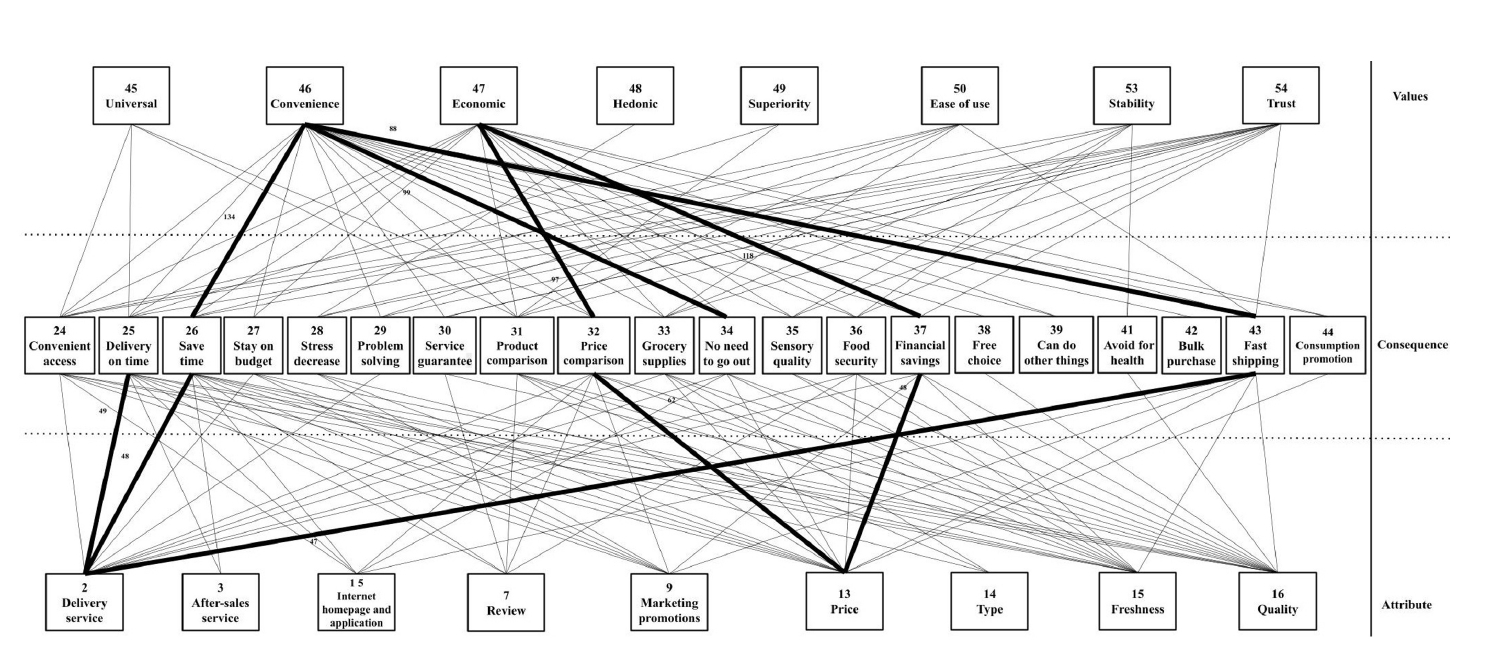
-
 Abstract
Abstract
 PDF
PDF - Objectives
Despite the growing market share of online grocery shopping, there is a need to understand customer perceived value due to the ongoing advancements in information technology. This study explores the connections between attributes, consequences, and values. Additionally, it conducts a cross-country comparison of consumers’ online grocery shopping behaviors to gain a deeper understanding of consumer market segments and any potential variations among them.
Methods
Data was collected through an online questionnaire survey conducted from May 1 to 15, 2024, targeting 400 consumers in Seoul, Korea, and Shanghai, China, who have experience with online grocery shopping. The survey utilized the Means-End Chain theory and association pattern technique hard laddering. Data collation and analysis were conducted using the IBM SPSS Statistics 28.0 program. The LadderUX software was employed to analyze the links between attributes, consequences, and values and create the consumer purchasing process’s implication matrix and hierarchical value map (HVM).
Results
The study identified key attributes that influence online grocery shopping decisions, including delivery service, price, freshness, and quality. Korean consumers demonstrated a higher sensitivity to price (19.0%) and delivery service (17.0%). In contrast, Chinese consumers prioritized delivery service (15.0%) and after-sales service (14.8%). Commonly cited consequences included time saving (12.6% for Koreans, 11.3% for Chinese), whereas prevalent values encompassed convenience (36.8% for Koreans, 19.6% for Chinese) and economic value (26.6% for Koreans, 14.7% for Chinese). The HVM underscored these insights, highlighting diverse consumer preferences and country-specific nuances.
Conclusions
The findings highlight the current state of online food consumption and consumers’ value systems, revealing variations among countries. These findings offer empirical insights that can be used to create customized global marketing strategies that resonate with various consumer preferences and market dynamics. -
Citations
Citations to this article as recorded by- Beyond the stage: how performing arts tourism shapes tourist perceptions and destination image
Islam Elbayoumi Salem, Mohammed Ali Bait Ali Sulaiman, Enrico di Bella, Sara Preti, Mohamed Kamal Abdien, Ahmed Magdy
Journal of Hospitality and Tourism Insights.2026; 9(1): 375. CrossRef
- Beyond the stage: how performing arts tourism shapes tourist perceptions and destination image
- 5,810 View
- 75 Download
- 1 Crossref

- [English]
- Effects of a nutrition education program on metabolic syndrome risk factors in middle-aged Korean adults: an intervention study
- Minji Kang, Young-Hee Park, Subeen Kim, Eunyoung Tak, Hyun Wook Baik, Hee Young Paik, Hyojee Joung
- Korean J Community Nutr 2024;29(4):265-277. Published online August 31, 2024
- DOI: https://doi.org/10.5720/kjcn.2024.00005
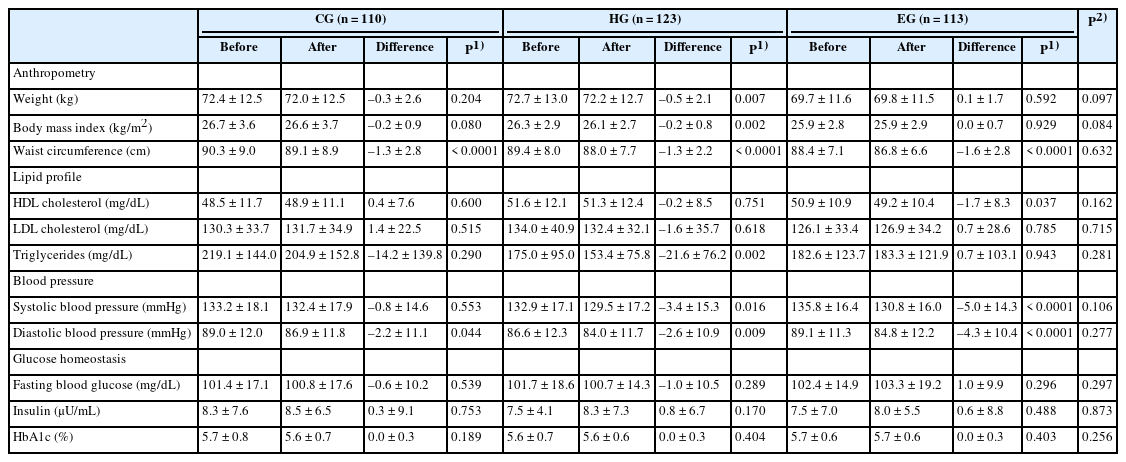
-
 Abstract
Abstract
 PDF
PDF - Objectives
This study was conducted to evaluate the effects of a nutrition education program on metabolic syndrome in middle-aged Korean adults.
Methods
A total of 411 Korean adults 30–59 years of age were allocated randomly into three groups: the nutrition education group for promoting Han-sik consumption (HG), the nutrition education group for eating balanced diet (EG), and the control group (CG). The HG and EG received four face-to-face nutrition education sessions over 16 weeks to improve nutritional problems based on the individual’ usual diet. Effectiveness of the program was evaluated with the differences of self-reported dietary behaviors, dietary intakes, anthropometric measurements and biochemical indices between the baseline and the end of the nutrition education program. The changes within groups were analyzed using paired t-test and McNemar test and effectiveness among three groups was analyzed by repeated analysis of variance.
Results
After the nutrition education, the percentages of participants who achieved the recommended food group consumption in the Korean Food Guidance Systems significantly increased in HG (P = 0.022). Body weight (P = 0.007), body mass index (P = 0.002), and triglycerides (P = 0.002) significantly decreased in HG. Waist circumference and diastolic blood pressure decreased in all three groups (P < 0.05).
Conclusions
This study found that tailored nutrition education program for middle aged Korean adults showed beneficial effects on improving dietary behaviors and metabolic syndrome risk factors. Further studies are needed to assess the long-term effects of the nutrition education programs on metabolic syndrome risks. -
Citations
Citations to this article as recorded by- Multicomponent intervention increases nutrition knowledge scores in rural China
Zhifan He, Ming Feng, Lu Li, Jing Li, Xiaohui Li
Scientific Reports.2025;[Epub] CrossRef
- Multicomponent intervention increases nutrition knowledge scores in rural China
- 4,237 View
- 85 Download
- 1 Crossref

- [English]
- Sex differences in health-related quality of life among older Korean adults with type 2 diabetes mellitus: a cross-sectional study
- Hyeonji Jeong, Kyong Park
- Korean J Community Nutr 2024;29(4):336-347. Published online August 31, 2024
- DOI: https://doi.org/10.5720/kjcn.2024.00003

-
 Abstract
Abstract
 PDF
PDF - Objectives
This cross-sectional study examined sex differences in Health-Related Quality of Life (HRQoL) among seniors with Type 2 Diabetes Mellitus (T2DM).
Methods
Data from the Korea National Health and Nutrition Examination Survey (2008–2020) were analyzed. The EuroQol-5 Dimensions (EQ-5D), a measure of HRQoL, was used. It comprises five dimensions: mobility, self-care, usual activity, pain/discomfort, and anxiety/depression, each with three levels.
Results
Analysis of 3,826 older adults with T2DM showed a significant increasing trend in the EQ-5D Index from the 4th survey phase onwards (P for trend < 0.001 for both men and women). Men consistently reported higher EQ-5D levels than women across all survey years. Women’s EQ-5D levels remained lower than men’s, maintaining a decade-old disparity (P < 0.05). Men scored significantly higher (P < 0.05) in most EQ-5D domains, except for self-care and anxiety/depression, resulting in a higher total EQ-5D Index (P = 0.001). Increased comorbidities were strongly associated with lower EQ-5D levels in both sexes. Additionally, there was a negative correlation between the EQ-5D Index and refined grain intake for both sexes (P for trend < 0.001), with high-EQ-5D groups consuming fewer refined grains. Women in the high-EQ-5D group consumed more nuts, vegetables, and meat compared to men (P for trend < 0.05).
Conclusions
Our study highlights the sex disparities in HRQoL among older adults with T2DM. The findings suggest the need for tailored treatment guidelines aimed at improving the HRQoL of elderly T2DM patients, with a focus on their sex-specific characteristics. Implementing these tailored guidelines could enhance the HRQoL of older women with T2DM and promote more equitable healthcare outcomes. This underscores the importance of considering sex differences to comprehensively improve the well-being of this population. -
Citations
Citations to this article as recorded by- Understanding Gender Disparities in Quality of Life Among Patients With Type 2 Diabetes in Ethiopia: An Institutional‐Based Study
Enguday Demeke Gebeyaw, Girma Deshimo Lema
Lifestyle Medicine.2025;[Epub] CrossRef
- Understanding Gender Disparities in Quality of Life Among Patients With Type 2 Diabetes in Ethiopia: An Institutional‐Based Study
- 2,584 View
- 40 Download
- 1 Crossref

- [English]
- Factors influencing consumers’ continuance intention in online grocery shopping: a cross-sectional study using application behavior reasoning theory
- Binglin Liu, Min A Lee
- Korean J Community Nutr 2024;29(3):199-211. Published online June 30, 2024
- DOI: https://doi.org/10.5720/kjcn.2024.29.3.199
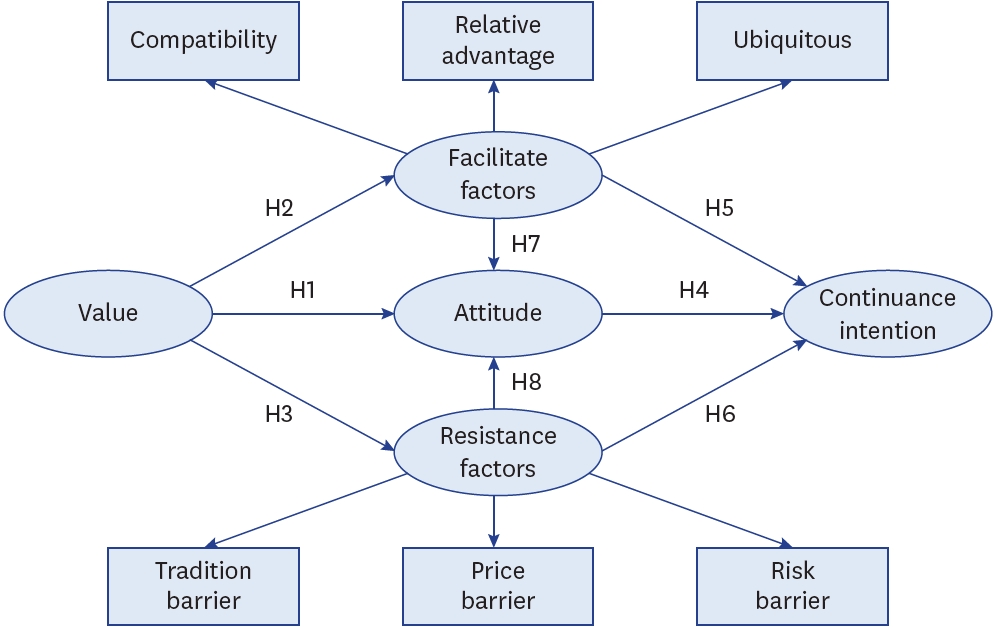
-
 Abstract
Abstract
 PDF
PDF - Objectives
Online grocery shopping has gained traction with the digital transformation of retail. This study constructs a behavioral model combining values, attitudes, and reasons for behavior—specifically, facilitators and resistance—to provide a more novel discussion and further understand the relative influences of the various factors affecting continuance intention in online grocery shopping.
Methods
Data were collected through an online questionnaire from consumers who had engaged in online grocery shopping during the past month in Seoul, Korea. All collected data were analyzed using descriptive analysis, and model validation was performed using partial least squares structural equation modeling.
Results
Continuance intention is primarily driven by facilitative factors (compatibility, relative advantage, and ubiquity). Attitude can also positively influence continuance intention. Although resistance factors (price, tradition, and risk) do not significantly affect continuance intention, they negatively affect attitude. Values significantly influence consumers’ reasoning processes but not their attitude.
Conclusions
These findings explain the key influences on consumers’ online grocery shopping behavior in Seoul and provide additional discussion and literature on consumer behavior and market management. To expand the online grocery market, consumers should be made aware of the potential benefits of the online channel; the barriers they encounter should be reduced. This will help sustain online grocery shopping behavior. Furthermore, its positive impact on attitude will further strengthen consumers’ continuance intention. -
Citations
Citations to this article as recorded by- Modelling the mass adoption potentials of fashion-augmented reality among the young consumers: evidence from an emerging economy
Mohima Akther, Mohammad Nurul Hassan Reza, Abdullah Al Mamun, Norzalita Abd Aziz, Marvello Yang
Journal of Fashion Marketing and Management: An International Journal.2025; 29(3): 459. CrossRef
- Modelling the mass adoption potentials of fashion-augmented reality among the young consumers: evidence from an emerging economy
- 7,429 View
- 86 Download
- 1 Crossref

- [English]
- Dietary intake and food sources of essential fatty acids among Korean adolescents: a cross-sectional study based on the 2016–2021 KNHANES data
- Enkhgerel Erdenetsetseg, Hye Ran Shin, SuJin Song
- Korean J Community Nutr 2024;29(2):144-155. Published online April 24, 2024
- DOI: https://doi.org/10.5720/kjcn.2024.29.2.144
-
 Abstract
Abstract
 PDF
PDF - Objectives
This study evaluated dietary intake and food sources of essential fatty acids in Korean adolescents.
Methods
This study was comprised of 3,932 adolescents (9–18 years) who participated in the 2016–2021 Korea National Health and Nutrition Examination Surveys. Dietary intake and food sources of essential fatty acids, including alpha-linolenic acid (ALA), eicosapentaenoic acid (EPA), docosahexaenoic acid (DHA), and linoleic acid (LA) were evaluated using data obtained from one-day 24-hour dietary recall. The proportions of adolescents consuming ALA, EPA + DHA, and LA above or below the adequate intake (AI) of the 2020 Dietary Reference Intakes for Koreans were calculated. All statistical analyses accounted for the complex sampling design effect and appropriate sample weights.
Results
The mean intakes of ALA, EPA, DHA, and LA among Korean adolescents were 1.29 g/day, 69.6 mg/day, 166.0 mg/day, and 11.1 g/day, respectively. Boys had higher intakes of all essential fatty acids compared to girls. By age group, adolescents aged 15–18 years showed lower intakes of EPA and DHA compared to adolescents in younger age groups. The 9–11-year-old adolescents had lower intakes of ALA and LA than older adolescents. The proportions of adolescents who consumed more than AI were 35.7% for ALA, 30.4% for EPA + DHA, and 41.5% for LA. Adherence to the AI for ALA did not differ by sex or age group, although boys showed a lower adherence to the AI for EPA + DHA than girls. Major food sources for ALA and LA were plant-based oils, mayonnaise, pork, and eggs. Mackerel was the most significant contributor to EPA and DHA intake (EPA, 22.6%; DHA, 22.2%), followed by laver, squid, and anchovy.
Conclusions
The proportion of Korean adolescents who consumed EPA + DHA more than AI was low. Our findings highlight that nutrition education emphasizing an intake of essential fatty acids from healthy food sources is needed among Korean adolescents. -
Citations
Citations to this article as recorded by- Harnessing dietary polyunsaturated fatty acids through gut microbiota to enhance ferroptosis in breast cancer therapy
Yara Adel Haroun, Abdulrahman Abdulla Alzyoud, Mohammad Taha Alizadeh, Nashwa Ahmed Mohamed, Riyad Bendardaf, Sameh S.M. Soliman
Nutrition Research.2025; 141: 10. CrossRef
- Harnessing dietary polyunsaturated fatty acids through gut microbiota to enhance ferroptosis in breast cancer therapy
- 3,887 View
- 59 Download
- 1 Crossref

- [English]
- Nutrition education programs necessary for social welfare facilities for persons with disabilities: a cross-sectional study
- Jinkyung Kim, Min-Sun Jeon
- Korean J Community Nutr 2024;29(1):1-15. Published online February 29, 2024
- DOI: https://doi.org/10.5720/kjcn.2024.29.1.1
-
 Abstract
Abstract
 PDF
PDF - Objectives
This study investigated the need for nutrition education aimed at improving the health of residents and users of social welfare facilities for persons with disability and aimed to provide basic information for developing a nutrition education program that meets the needs of the field.
Methods
Altogether, 249 employees working in social welfare facilities for people with disabilities were included in the study. Data on the health status of residents/users, meal management, nutritional education, nutritional education needs, and awareness of nutritional education were obtained through online surveys. A descriptive analysis was conducted to analyze the demographic characteristics, needs, and perceptions of the respondents, and independent t-tests and χ2 tests were performed to analyze and compare the differences between residential and daycare facilities.
Results
The majority of residents/users of social welfare facilities for persons with disabilities have developmental disabilities. When educating residents with residents/users of social welfare facilities, ‘personal hygiene’ was the most necessary topic, followed by ‘obesity management’ education. Regarding the methods of providing education, face-to-face lectures demonstrated a high demand. They responded that when nutrition education experts provide nutrition education to people with disabilities, they must understand ‘the physical characteristics of persons with disabilities’ and have the ability to determine appropriate nutrition for such people. The most appropriate nutrition program training would be twice a year, lasting 30 min to 1 h per training session.
Conclusions
It will present a direction for operating a nutrition education program for persons with disabilities that meets their needs of social welfare facilities and ultimately contribute to the establishment and activation of nutrition education tailored to welfare facilities for such individuals in Korea. -
Citations
Citations to this article as recorded by- Development and applicability evaluation of a nutrition education program for residents and users of disability social welfare facilities in Korea: a mixed-methods study
Jin-kyung Kim, Kyoung-min Lee, Min-sun Jeon
Korean Journal of Community Nutrition.2025; 30(1): 64. CrossRef
- Development and applicability evaluation of a nutrition education program for residents and users of disability social welfare facilities in Korea: a mixed-methods study
- 2,550 View
- 44 Download
- 1 Crossref


 KSCN
KSCN

 First
First Prev
Prev



